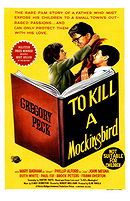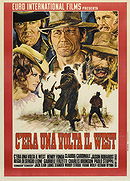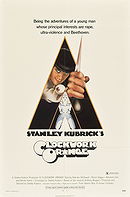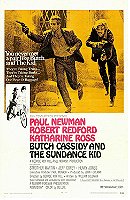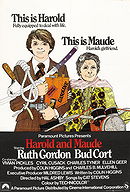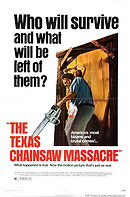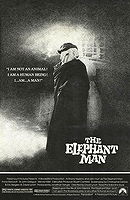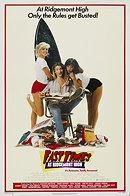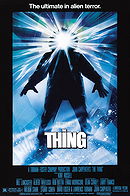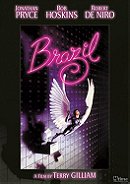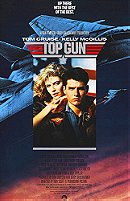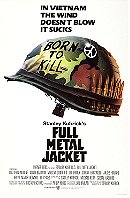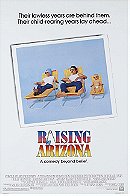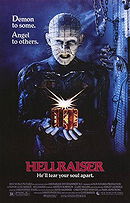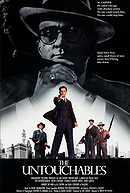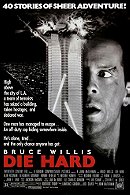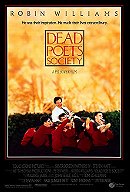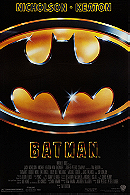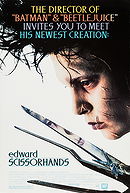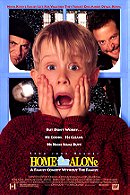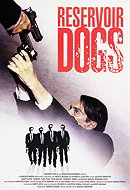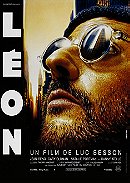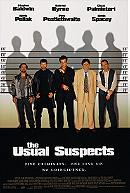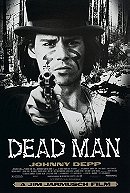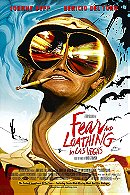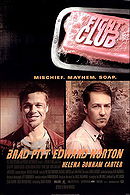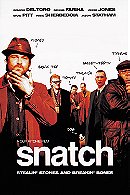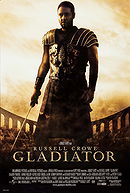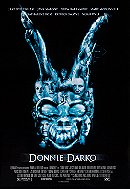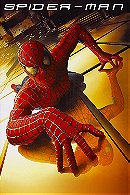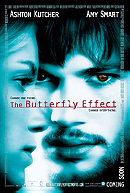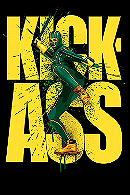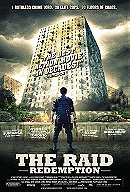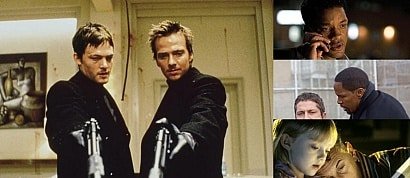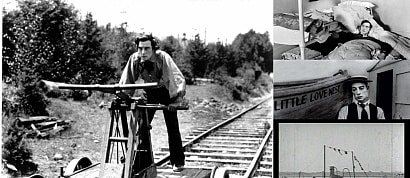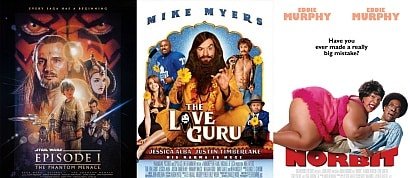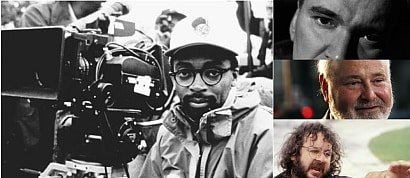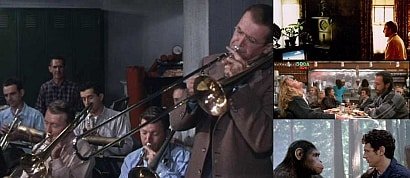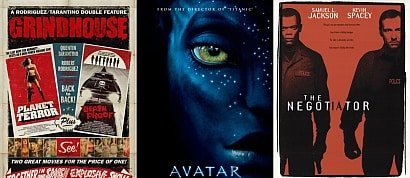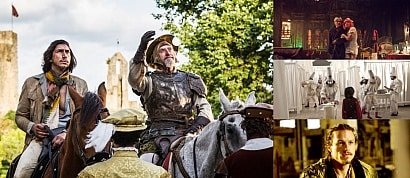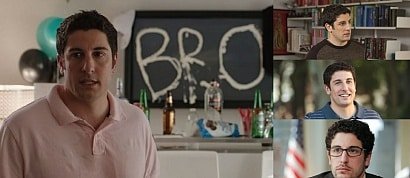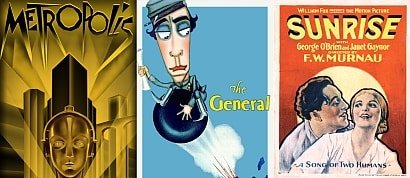Roger Ebert didn't like all the Classics
Sort by:
Showing 41 items
Decade:
Rating:
List Type:
Godzilla (1954)
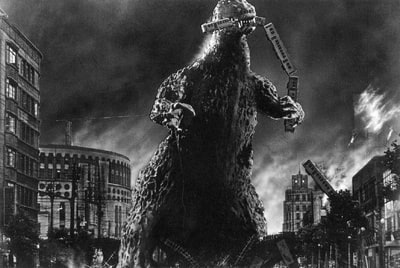
His Review :
Regaled for 50 years by the stupendous idiocy of the American version of "Godzilla," audiences can now see the original Japanese version, which is equally idiotic, but, properly decoded, was the "Fahrenheit 9/11" of its time. Both films come after fearsome attacks on their nations, embody urgent warnings, and even incorporate similar dialogue, such as "The report is of such dire importance it must not be made public." Is that from 1954 Tokyo or 2004 Washington?
The first "Godzilla" set box office records in Japan and inspired countless sequels, remakes and rip-offs. It was made shortly after an American H-bomb test in the Pacific contaminated a large area of ocean and gave radiation sickness to a boatload of Japanese fishermen. It refers repeatedly to Nagasaki, H-bombs and civilian casualties, and obviously embodies Japanese fears about American nuclear tests.
The military battles Godzilla as the monster terrorizes the citizens of Tokyo in this scene from the 1954 Japanese film version of "Godzilla.
(Enlarge Image)But that is not the movie you have seen. For one thing, it doesn't star Raymond Burr as Steve Martin, intrepid American journalist, who helpfully explains, "I was headed for an assignment in Cairo when I dropped off for a social call in Tokyo."
In the '50s, the American producer Joseph E. Levine bought the Japanese film, cut it by 40 minutes, removed all of the political content, and awkwardly inserted Burr into scenes where he clearly did not fit. The hapless actor gives us reaction shots where he's looking in the wrong direction, listens to Japanese actors dubbed into the American idiom (they always call him, "Steve Martin" or even "the famous Steve Martin"), and provides a reassuring conclusion in which Godzilla is seen as some kind of public health problem, or maybe just a malcontent.
The Japanese version, now in general U.S. release to mark the film's 50th anniversary, is a bad film, but with an undeniable urgency. I learn from helpful notes by Mike Flores of the Psychotronic Film Society that the opening scenes, showing fishing boats disappearing as the sea boils up, would have been read by Japanese audiences as a coded version of U.S. underwater H-bomb tests. Much is made of a scientist named Dr. Serizawa (Akihiko Hirata), who could destroy Godzilla with his secret weapon, the Oxygen Destroyer, but hesitates because he is afraid the weapon might fall into the wrong hands, just as H-bombs might, and have. The film's ending warns that atomic tests may lead to more Godzillas. All cut from the U.S. version.
In these days of flawless special effects, Godzilla and the city he destroys are equally crude. Godzilla at times looks uncannily like a man in a lizard suit, stomping on cardboard sets, as indeed he was, and did. Other scenes show him as a stuffed, awkward animatronic model. This was not state of the art even at the time; "King Kong" (1933) was much more convincing.
When Dr. Serizawa demonstrates the Oxygen Destroyer to the fiancee of his son, the superweapon is somewhat anticlimactic. He drops a pill into a tank of tropical fish, the tank lights up, he shouts "stand back!," the fiancee screams, and the fish go belly up. Yeah, that'll stop Godzilla in his tracks.
Reporters covering Godzilla's advance are rarely seen in the same shot with the monster. Instead, they look offscreen with horror; a TV reporter, broadcasting for some reason from his station's tower, sees Godzilla looming nearby and signs off, "Sayonara, everyone!" Meanwhile, searchlights sweep the sky, in case Godzilla learns to fly.
The movie's original Japanese dialogue, subtitled, is as harebrained as Burr's dubbed lines. When the Japanese Parliament meets (in what looks like a high school home room), the dialogue is portentous but circular:
"The professor raises an interesting question! We need scientific research!"
"Yes, but at what cost?"
"Yes, that's the question!"
Is there a reason to see the original "Godzilla"? Not because of its artistic stature, but perhaps because of the feeling we can sense in its parable about the monstrous threats unleashed by the atomic age. There are shots of Godzilla's victims in hospitals, and they reminded me of documentaries of Japanese A-bomb victims. The incompetence of scientists, politicians and the military will ring a bell.
This is a bad movie, but it has earned its place in history, and the enduring popularity of Godzilla and other monsters shows that it struck a chord. Can it be a coincidence, in these years of trauma after 9/11, that in a 2005 remake, King Kong will march once again on New York?
His Rating :
suggested by AVPGuyver21
To Kill a Mockingbird (1962)

His Review :
"To Kill a Mockingbird" is a time capsule, preserving hopes and sentiments from a kinder, gentler, more naive America. It was released in December 1962, the last month of the last year of the complacency of the postwar years. The following November, John F. Kennedy would be assassinated. Nothing would ever be the same again -- not after the deaths of Martin Luther King, Robert Kennedy, Malcolm X, Medgar Evers, not after the war in Vietnam, certainly not after September 11, 2001. The most hopeful development during that period for America was the civil rights movement, which dealt a series of legal and moral blows to racism. But "To Kill a Mockingbird," set in Maycomb, Alabama, in 1932, uses the realities of its time only as a backdrop for the portrait of a brave white liberal.
The movie has remained the favorite of many people. It is currently listed as the 29th best film of all time in a poll by the Internet Movie Database. Such polls are of questionable significance, but certainly the movie and the Harper Lee novel on which it is based have legions of admirers. It is being read by many Chicagoans as part of a city-wide initiative in book discussion. It is a beautifully-written book, but it should be used not as a record of how things are, or were, but of how we once liked to think of them.
The novel, which focuses on the coming of age of three young children, especially the tomboy Scout, gains strength from her point of view: It sees the good and evil of the world through the eyes of a six-year-old child. The movie shifts the emphasis to the character of her father, Atticus Finch, but from this new point of view doesn't see as much as an adult in that time and place should see.
Maycomb is evoked by director Robert Mulligan as a "tired old town" of dirt roads, picket fences, climbing vines, front porches held up by pillars of brick, rocking chairs, and Panama hats. Scout (Mary Badham) and her 10-year-old brother Jem (Philip Alford) live with their widowed father Atticus Finch (Gregory Peck) and their black housekeeper Calpurnia (Estelle Evans). They make friends with a new neighbor named "Dill" Harris (John Megna), who wears glasses, speaks with an expanded vocabulary, is small for his age, and is said to be inspired by Harper Lee's childhood friend Truman Capote. Atticus goes off every morning to his law office downtown, and the children play through lazy hot days.
Their imagination is much occupied by the Radley house, right down the street, which seems always dark, shaded and closed. Jem tells Dill that Mr. Radley keeps his son Boo chained to a bed in the house, and describes Boo breathlessly: "Judging from his tracks, he's about six and a half feet tall. He eats raw squirrels and all the cats he can catch. There's a long, jagged scar that runs all the way across his face. His teeth are yellow and rotten. His eyes are popped. And he drools most of the time." Of course the first detail reveals Jem has never seen Boo.
Into this peaceful calm drops a thunderbolt. Atticus is asked by the town judge to defend a black man named Tom Robinson (Brock Peters), who has been accused of raping a poor white girl named Mayella Violet Ewell (Collin Wilcox). White opinion is of course much against the black man, who is presumed guilty, and Mayelle's father Bob (James Anderson) pays an ominous call on Atticus, indirectly threatening his children. The children are also taunted at school, and get in fights; Atticus explains to them why he is defending a Negro, and warns them against using the word "nigger."
The courtroom scenes are the most celebrated in the movie; they make it perfectly clear that Tom Robinson is innocent, that no rape occurred, that Maybelle came on to Robinson, that he tried to flee, that Bob Ewell beat his own daughter, and she lied about it out of shame for feeling attracted to a black man. Atticus' summation to the jury is one of Gregory Peck's great scenes, but of course the all-white jury finds Tom Robinson guilty anyway. The verdict is greeted by an uncanny quiet: No whoops of triumph from Bob Ewell, no cries of protests by the blacks in the courtroom gallery. The whites file out quickly, but the blacks remain and stand silently in honor of Atticus as he walks out a little later. Scout and her brother sat up with the blacks throughout the trial, and now a minister tells her: "Miss Jean Louise, stand up, your father's passin'."
The problem here, for me, is that the conviction of Tom Robinson is not the point of the scene, which looks right past him to focus on the nobility of Atticus Finch. I also wonder at the general lack of emotion in the courtroom, and the movie only grows more puzzling by what happens next. Atticus is told by the sheriff that while Tom Robinson was being taken for safekeeping to nearby Abbottsville, he broke loose and tried to run away. As Atticus repeats the story: "The deputy called out to him to stop. Tom didn't stop. He shot at him to wound him and missed his aim. Killed him. The deputy says Tom just ran like a crazy man."
That Scout could believe it happened just like this is credible. That Atticus Finch, an adult liberal resident of the Deep South in 1932, has no questions about this version is incredible. In 1962 it is possible that some (white) audiences would believe that Tom Robinson was accidentally killed while trying to escape, but in 2001 such stories are met with a weary cynicism.
The construction of the following scene is highly implausible. Atticus drives out to Tom Robinson's house to break the sad news to his widow, Helen. She is played by Kim Hamilton (who is not credited, and indeed has no speaking lines in a film that finds time for dialog by two superfluous white neighbors of the Finches). On the porch are several male friends and relatives. Bob Ewell, the vile father who beat his girl into lying, lurches out of the shadows and says to one of them, "Boy, go in the house and bring out Atticus Finch." One of the men does so, Ewell spits in Atticus's face, Atticus stares him down and drives away. The black people in this scene are not treated as characters, but as props, and kept entirely in long shot. The close-ups are reserved for the white hero and villain.
It may be that in 1932 the situation was such in Alabama that this white man, who the people on that porch had seen lie to convict Tom Robinson, could walk up to them alone after they had just learned he had been killed, call one of them "boy," and not be touched. If black fear of whites was that deep in those days, then the rest of the movie exists in a dream world.
The upbeat payoff involves Ewell's cowardly attack on Scout and Jem, and the sudden appearance of the mysterious Boo Radley (Robert Duvall, in his first screen performance), to save them. Ewell is found dead with a knife under his ribs. Boo materializes inside the Finch house, is identified by Scout as her savior, and they're soon sitting side by side on the front porch swing. The sheriff decides that no good would be served by accusing Boo of the death of Ewell. That would be like "killing a mockingbird," and we know from earlier in the film that you can shoot all the bluejays you want, but not mockingbirds -- because all they do is sing to bring music to the garden. Not exactly a description of the silent Boo Radley, but we get the point.
This is a tricky note to end on, because it brings Boo Radley in literally from the wings as a distraction from the facts: An innocent black man was framed for a crime that never took place, he was convicted by a white jury in the face of overwhelming evidence, and he was shot dead in problematic circumstances. Now we are expected to feel good because the events got Boo out of the house. That Boo Radley killed Bob Ewell may be justice, but it is not parity. The sheriff says, "There's a black man dead for no reason, and now the man responsible for it is dead. Let the dead bury the dead this time." But I doubt that either Tom Robinson or Bob Ewell would want to be buried by the other.
"To Kill a Mockingbird" is, as I said, a time capsule. It expresses the liberal pieties of a more innocent time, the early 1960s, and it goes very easy on the realities of small-town Alabama in the 1930s. One of the most dramatic scenes shows a lynch mob facing Atticus, who is all by himself on the jailhouse steps the night before Tom Robinson's trial. The mob is armed and prepared to break in and hang Robinson, but Scout bursts onto the scene, recognizes a poor farmer who has been befriended by her father, and shames him (and all the other men) into leaving. Her speech is a calculated strategic exercise, masked as the innocent words of a child; one shot of her eyes shows she realizes exactly what she's doing. Could a child turn away a lynch mob at that time, in that place? Isn't it nice to think so.
His Rating :

johanlefourbe's rating:


Once Upon a Time in the West (1968)

His Review :
Sergio Leone's "Once Upon a Time in the West" is a painstaking distillation of the style he made famous in the original three Clint Eastwood Westerns. There's the same eerie music; the same sweaty, ugly faces; the same rhythm of waiting and violence; the same attention to small details of Western life.
There is also, unfortunately, Leone's inability to call it quits. The movie stretches on for nearly three hours, with intermission, and provides two false alarms before it finally ends. In between, we're given a plot complex enough for Antonioni, involving killers, land rights, railroads, long-delayed revenge, mistaken identity, love triangles, double-crosses and shoot-outs. We're well into the second hour of the movie before the plot becomes quite clear.
These difficulties notwithstanding, "Once Upon a Time in the West" is good fun, especially if you like Leone's way of savoring the last morsel of every scene. A final shoot-out between Henry Fonda and Charles Bronson, for example, takes at least 15 minutes. They walk. They wait. They circle each other. They stare at each other. They squint. They spit. They take off their jackets. They wince. Just when they finally seem prepared to shoot after all, Leone uses a flashback. But why hurry a good shoot-out?
Leone's first two "spaghetti Westerns" ("A Fistful of Dollars," "For a Few Dollars More") were made with small budgets. His third, "The Good, the Bad and the Ugly," was made with a few dollars more. But this one was bankrolled by Paramount and looks like it: There's a wealth of detail, a lot of extras, elaborate sets. There's a sense of the life of the West going on all around the action (and that sense is impossible to obtain on small budgets).
Leone produces some interesting performances by casting against type. Henry Fonda is the bad guy for once in his career; Charles Bronson is impressively inscrutable as the mysterious good guy; and Jason Robards is a tough guy, believe it or not. Claudia Cardinale was a good choice for the woman, but Leone directs her too passively; in "Cartouche," she demonstrated a blood-and-thunder abandon that's lacking here.
His Rating :

suggested by thenoah
johanlefourbe's rating:


A Clockwork Orange (1971)

His Review :
Stanley Kubrick's "A Clockwork Orange" is an ideological mess, a paranoid right-wing fantasy masquerading As an Orwellian warning. It pretends to oppose the police state and forced mind control, but all it really does is celebrate the nastiness of its hero, Alex.
I don't know quite how to explain my disgust at Alex (whom Kubrick likes very much, as his visual style reveals and as we shall see in a moment). Alex is the sort of fearsomely strange person we've all run across a few times in our lives -- usually when he and we were children, and he was less inclined to conceal his hobbies. He must have been the kind of kid who tore off the wings of flies and ate ants just because that was so disgusting. He was the kid who always seemed to know more about sex than anyone else, too -- and especially about how dirty it was.
Alex has grown up in "A Clockwork Orange," and now he's a sadistic rapist. I realize that calling him a sadistic rapist -- just like that -- is to stereotype poor Alex a little. But Kubrick doesn't give us much more to go on, except that Alex likes Beethoven a lot. Why he likes Beethoven is never explained, but my notion is that Alex likes Beethoven in the same way that Kubrick likes to load his sound track with familiar classical music -- to add a cute, cheap, dead-end dimension.
Now Alex isn't the kind of sat-upon, working-class anti-hero we got in the angry British movies of the early 1960s. No effort is made to explain his inner workings or take apart his society. Indeed, there's not much to take apart; both Alex and his society are smart-nose pop-art abstractions. Kubrick hasn't created a future world in his imagination -- he's created a trendy decor. If we fall for the Kubrick line and say Alex is violent because "society offers him no alternative," weep, sob, we're just making excuses.
Alex is violent because it is necessary for him to be violent in order for this movie to entertain in the way Kubrick intends. Alex has been made into a sadistic rapist not by society, not by his parents, not by the police state, not by centralization and not by creeping fascism -- but by the producer, director and writer of this film, Stanley Kubrick. Directors sometimes get sanctimonious and talk about their creations in the third person, as if society had really created Alex. But this makes their direction into a sort of cinematic automatic writing. No, I think Kubrick is being too modest: Alex is all his.
I say that in full awareness that "A Clockwork Orange" is based, somewhat faithfully, on a novel by Anthony Burgess. Yet I don't pin the rap on Burgess. Kubrick has used visuals to alter the book's point of view and to nudge us toward a kind of grudging pal-ship with Alex.
Kubrick's most obvious photographic device this time is the wide-angle lens. Used on objects that are fairly close to the camera, this lens tends to distort the sides of the image. The objects in the center of the screen look normal, but those on the edges tend to slant upward and outward, becoming bizarrely elongated. Kubrick uses the wide-angle lens almost all the time when he is showing events from Alex's point of view; this encourages us to see the world as Alex does, as a crazy-house of weird people out to get him.
When Kubrick shows us Alex, however, he either places him in the center of a wide-angle shot (so Alex alone has normal human dimensions,) or uses a standard lens that does not distort. So a visual impression is built up during the movie that Alex, and only Alex, is normal.
Kubrick has another couple of neat gimmicks to build Alex into a hero instead of a wretch. He likes to shoot Alex from above, letting Alex look up at us from under a lowered brow. This was also a favorite Kubrick angle in the close-ups in "2001: A Space Odyssey," and in both pictures, Kubrick puts the lighting emphasis on the eyes. This gives his characters a slightly scary, messianic look.
And then Kubrick makes all sorts of references at the end of "A Clockwork Orange" to the famous bedroom (and bathroom) scenes at the end of "2001." The echoing water-drips while Alex takes his bath remind us indirectly of the sound effects in the "2001" bedroom, and then Alex sits down to a table and a glass of wine. He is photographed from the same angle Kubrick used in "2001" to show us Keir Dullea at dinner. And then there's even a shot from behind, showing Alex turning around as he swallows a mouthful of wine.
This isn't just simple visual quotation, I think. Kubrick used the final shots of "2001" to ease his space voyager into the Space Child who ends the movie. The child, you'll remember, turns large and fearsomely wise eyes upon us, and is our savior. In somewhat the same way, Alex turns into a wide eyed child at the end of "A Clockwork Orange," and smiles mischievously as he has a fantasy of rape. We're now supposed to cheer because he's been cured of the anti-rape, anti-violence programming forced upon him by society during a prison "rehabilitation" process.
What in hell is Kubrick up to here? Does he really want us to identify with the antisocial tilt of Alex's psychopathic little life? In a world where society is criminal, of course, a good man must live outside the law. But that isn't what Kubrick is saying, He actually seems to be implying something simpler and more frightening: that in a world where society is criminal, the citizen might as well be a criminal, too.
Well, enough philosophy. We'll probably be debating "A Clockwork Orange" for a long time -- a long, weary and pointless time. The New York critical establishment has guaranteed that for us. They missed the boat on "2001," so maybe they were trying to catch up with Kubrick on this one. Or maybe the news weeklies just needed a good movie cover story for Christmas.
I don't know. But they've really hyped "A Clockwork Orange" for more than it's worth, and a lot of people will go if only out of curiosity. Too bad. In addition to the things I've mentioned above -- things I really got mad about -- "A Clockwork Orange" commits another, perhaps even more unforgivable, artistic sin. It is just plain talky and boring. You know there's something wrong with a movie when the last third feels like the last half.
His Rating :
johanlefourbe's rating:



His Review :
"Butch Cassidy and the Sundance Kid" must have looked like a natural on paper, but, alas, the completed film is slow and disappointing. This despite the fact that it contains several good laughs and three sound performances.
The problems are two. First, the investment in superstar Paul Newman apparently inspired a bloated production that destroys the pacing. Second, William Goldman's script is constantly too cute and never gets up the nerve, by God, to admit it's a Western.
The premise was promising. Butch (Newman) and Sundance (Robert Redford) were two Western outlaws (unsung until now) who led a gang of cutthroat train robbers. But when Harriman, the railroad tycoon, got up a special posse of experts to hunt them, they lit out for Bolivia and stuck up banks there. You can see, in "Butch Cassidy and the Sundance Kid," the bones of the good movie that could have been made about them.
But unfortunately, this good movie is buried beneath millions of dollars that were spent on "production values" that wreck the show. This is often the fate of movies with actors in the million-dollar class, like Newman. Having invested all that cash in the superstar, the studio gets nervous and decides to spend lots of money to protect its investment.
That's what happened here. The movie starts promisingly, with an amusing period-piece newsreel about the Cassidy gang. And then there is a scene in a tavern where Sundance faces down a tough gambler, and that's good. And then a scene where Butch puts down a rebellion in his gang, and that's one of the best things in the movie. And then an extended bout of train-robbing, climaxing in a dynamite explosion that'll have you rolling in the aisles. And then we meet Sundance's girlfriend, played by Katharine Ross, and the scenes with the three of them have you thinking you've wandered into a really first-rate film.
But the trouble starts after Harriman hires his posse. It's called the Super-posse because it includes all the best lawmen and trackers in the West. When it approaches, the ground rumbles and we get the feeling it's a supernatural force. Butch and the Kid try to hide in the badlands, but the Super-posse cannot be fooled. It's always on their track. Forever.
Director George Roy Hill apparently spent a lot of money to take his company on location for these scenes, and I guess when he got back to Hollywood he couldn't bear to edit them out of the final version. So the Super-posse chases our heroes unceasingly, until we've long since forgotten how well the movie started and are desperately wondering if they'll ever get finished riding up and down those endless hills. And once bogged down, the movie never recovers.
It does show moments of promise, however, after Butch, the Kid and his girl go to Bolivia. There are some funny difficulties with Spanish, for example. But here the script throws us off. Goldman has his heroes saying such quick, witty and contemporary things that we're distracted: it's as if, in 1910, they were consciously speaking for the benefit of us clever 1969 types.
This dialog is especially inappropriate in the final shoot-out, when it gets so bad we can't believe a word anyone says. And then the violent, bloody ending is also a mistake; apparently it was a misguided attempt to copy "Bonnie and Clyde." But the ending doesn't belong on "Butch Cassidy," and we don't believe it, and we walk out of the theater wondering what happened to that great movie we were seeing until an hour ago.
His Rating :

suggested by Michael M
johanlefourbe's rating:


Straw Dogs (1971)

His Review :
Sam Peckinpah's "The Wild Bunch," one of the great movies of the decade, saw violence as essentially unselective. That was unusual in a Western, where violence has always been highly selective; with all those bullets flying around, you might get a good guy wounded once in a while, but somehow, mostly bad guys got killed.
The Western reflected our national view of violence, of foreign policy, of a lot of things. But Peckinpah seemed to be recasting it in a new mold, throwing out the moral extremes and stranding everyone in a gray, blood-soaked middle ground. In the shoot-out at the end of "The Wild Bunch," everyone caught it: men, women, children, dogs, chickens, regardless of guilt or innocence.
"The Wild Bunch" was attacked because of its nihilism, but I didn't see it that way. It seemed to me that Peckinpah was simply clearing away the moralistic oatmeal so we could see what was beneath the Western -- and beneath our regard for it.
For a long time, the old Hollywood production code required that justice be rewarded and evil punished (a requirement that inspired not a few bizarre endings for gangster movies). But even after the production code was junked, the Western still subscribed to it. We wanted it to.
Peckinpah was asking us not to kid ourselves, I thought. But now he comes along with "Straw Dogs," a major disappointment in which Peckinpah's theories about violence seem to have regressed to a sort of 19th-Century mixture of Kipling and machismo.
You have to understand, first of all, that the movie ends with maybe 20 minutes of unrestrained bloodletting, during which people are scalded with boiling whisky, have their feet blown off by shotguns, are clubbed to death and (in one case) nearly decapitated by a bear trap. The violence is the movie's reason for existing; it is the element that is being sold, and in today's movie market, It should sell well. But does Peckinpah pay his dues before the last 20 minutes? Does he keep us feeling we can trust him? I don't think so.
The movie is set in a British village apparently populated only by the movie's cast. This is a little unsettling, but we soon find that we don't need extras because the movie is going to be in close-up, and the close-ups are going to be of grotesque, melodramatic parodies, larger than life and smaller than cliche.
The movie's first shot is of children torturing a dog; the first shot of "The Wild Bunch" was of children torturing a scorpion. This has gotten to be Peckinpah's trademark, sort of his Leo the Lion, advertising his baleful opinion of the human prospect. A young American mathematician (Dustin Hoffman) comes to the village with his wife (Susan George), an English girl whose father owns a home there. They plan to make repairs and settle down while he gets on with his work. His work involves theory on the interiors of stars, but never mind; for Peckinpah's purposes he is an Intellectual.
That means of course that he lacks physical courage, can't mix freely with the local roughhouses, and manages by his every thought and deed to alienate all Good Old Boys everywhere. During one brief scene in the local pub, he manages to do no less than three terrible things: He orders "any kind of American cigarettes," he walks between a dart-player and his board and he buys a drink for the house but does not stay to have it. Such a boor deserves his comeuppance, and this being a Peckinpah universe, we somehow know it will involve rape and murder.
A gang of local handymen and layabouts come to fix the young couple's garage, and we learn that one of the men once went with the girl. He resents the American terribly, of course, and begins to taunt him in various ways. Their cat is hanged in the closet and things like that.
Meanwhile, Peckinpah is setting us up for the conclusion with a series of scenes that outdo anything Western Union has yet achieved with the telegraph. We meet the village idiot, a towering, blank-eyed chap who "made a mistake" once with a girl. We meet the town tart, who is a tight-sweatered tease. We learn that her father is the crudest man in the local pub. As sure as when Garbo coughs we know she's got TB, we know the idiot is going to go after the girl, and the brute is going to go after the idiot.
Through a series of melodramatic coincidences, the idiot winds up in the mathematician's barricaded house, while the lout and four or five drunken friends try to break in. They already have shot the magistrate dead, and now they demand the life of the idiot. Hoffman, taking a Moral Stand for once in his life, decides his home is his castle, etc. He figures out all the tricks like the boiling whisky.
The problem with this whole scene is that we have to believe the behavior of the men outside. They are drunk, and they are capable of total physical savagery without any thought of their own danger, it would appear. Getting into that house is worth their lives to them.
Well, the hard thing to believe is that anyone could get drunk enough to get into that state of frenzy and still be sober enough to do anything about it. One or two guys, maybe, But half a dozen? As they hurl themselves against Hoffman's barricades, we realize that everything is a setup to allow more variety in the violence.
And then the movie ends with the worst piece of pseudo-serious understatement since Peyton Place left the air. After Hoffman has killed them all, he drives the idiot back to the village.
"I don't know where I live," the idiot says.
"That's all right," says Hoffman, "neither do I."
What conclusions are we supposed to draw? That Hoffman achieved defeat in victory? That Peckinpah believes in the concept of a Just War? That drink drives men to the grave?
The most offensive thing about the movie is its hypocrisy; it is totally committed to the pornography of violence, but lays on the moral outrage with a shovel. The perfect criticism of "Straw Dogs" already has been made. It is "The Wild Bunch."
His Rating :
johanlefourbe's rating:


Harold and Maude (1971)

His Review :
Death can be as funny as most things in life, I suppose, but not the way Harold and Maude go about it. They meet because they're both funeral freaks, and one day their eyes lock over a grave. They fall into conversation after Maude steals Harold's hearse and offers him a ride. Harold drives a hearse, by the way, because he is fascinated by death, particularly his own. So fascinated that maybe the only reason he doesn't kill himself is that suicide would put an end to his suicide fantasies. You can see that Harold is a young man with a problem.
Now Maude, on the other hand, is seventy-nine years young, and has what is known in the trade as a lust for life. She lives in a railroad car, spends her afternoons uprooting city trees and returning them to the forest, and in general is an all-round booster of the life force. She goes to funerals because there is a time to live and a time to die, and she wants to be on time.
The word has gotten out that "Harold and Maude" is the story of a love affair between these two people. It is not, so necrophiliacs please stay cool. It is about how Harold annoys (yes, annoys would be the word) his mother by staging a staggering variety of suicide attempts. Let's see. There's immolation, hanging, whacking off his arm with a meat cleaver, driving his car over a cliff, drowning, and if I missed one, never mind. But his mother is merely annoyed. She takes a morning dip in the swimming pool, for example, and when she comes upon Harold's body floating face down, she merely swims another lap. Talk about exercise freaks.
Harold's mother figures maybe what Harold needs is a little female companionship. She signs him up with a computer dating service, but the girls are sort of put off when he sets himself afire on their date, and things like that. Maude, on the other hand, doesn't seem to mind. As played by Ruth Gordon, she is the same wise-cracking operator out of the side of the mouth that we met in "Rosemary's Baby." When a traffic cop stops her for being in possession of a stolen truck, a stolen car, and a stolen shovel, she apologizes and then drives away. When he catches up with her again, she steals his motorcycle. You see what an indomitable sort she is.
Harold is played by Bud Cort, the round-eyed and solemn-mouthed announcer over the PA system in "M*A*S*H." He is even rounder and more solemn this time, having perfected a funereal droop of the lower lip. It is hard to get very much animation into a character who is obsessed with his own oblivion, but Cort doesn't even try.
And so what we get, finally, is a movie of attitudes. Harold is death, Maude life, and they manage to make the two seem so similar that life's hardly worth the extra bother. The visual style makes everyone look fresh from the Wax Museum, and all the movie lacks is a lot of day-old gardenias and lilies and roses in the lobby, filling the place with a cloying sweet smell. Nothing more to report today. Harold doesn't even make pallbearer.
His Rating :
suggested by Mr. Saturn
The Texas Chainsaw Massacre (1974)

His Review :
Now here’s a grisly little item. “The Texas Chainsaw Massacre” is as violent and gruesome and blood-soaked as the title promises -- a real Grand Guignol of a movie. It’s also without any apparent purpose, unless the creation of disgust and fright is a purpose. And yet in its own way, the movie is some kind of weird, off-the-wall achievement. I can’t imagine why anyone would want to make a movie like this, and yet it’s well-made, well-acted, and all too effective.
The movie’s based on factual material, according to the narration that opens it. For all I know, that’s true, although I can’t recall having heard of these particular crimes, and the distributor provides no documentation. Not that it matters. A true crime movie like Richard Brooks’ “In Cold Blood,” which studies the personalities and compulsions of two killers, dealt directly with documented material and was all the more effective for that. But “The Texas Chainsaw Massacre” could have been made up from whole cloth without any apparent difference. No motivation, no background, no speculation on causes is evident anywhere in the film. It’s simply an exercise in terror.
It takes place in an isolated area of Texas, which five young people (one of them in a wheelchair) are driving through in their camper van. They pick up a weirdo hitchhiker who carries his charms and magic potions around his neck and who giggles insanely while he cuts himself on the hand and then slices at the paraplegic. They get rid of him, so they think.
But then they take a side trip to a haunted-looking old house, which some of them had been raised in. The two girls laugh as they clamber through the litter on the floor, but one of the guys notices some strange totems and charms which should give him warning. They don’t. He and his girlfriend set off for the old swimming hole, find it dried up, and then see a farmhouse nearby. The guy goes to ask about borrowing some gasoline and disappears inside.
His girl gets tired of waiting for him, knocks on the door, and disappears inside, too. A lot of people are going to be disappearing into this house, and its insides are a masterpiece of set decoration and the creation of mood. We see the innocent victims being clubbed on the hand, hung from meat hooks, and gone after with the chain saw.
We see rooms full of strange altars made from human bones, and rooms filled with chicken feathers and charms and weird relics. And gradually we realize that the house is inhabited by a demented family of retarded murderers and grave robbers. When they get fresh victims, they carve them up with great delight. What they do with the bodies is a little obscure, but, uh, they run a barbecue stand down by the road.
One way or another, all the kids get killed by the maniac waving the chain saw -- except one girl, who undergoes a night of panic and torture, who escapes not once but twice, who leaps through no fewer than two windows, and who screams endlessly. All of this material, as you can imagine, is scary and unpalatable. But the movie is good technically and with its special effects, and we have to give it grudging admiration on that level, despite all the waving of the chain saw.
There is, for example, an effective montage of quick cuts of the last girl’s screaming face and popping eyeballs. There are bizarrely effective performances by the demented family (one of them, of course, turns out to be the hitchhiker, and Grandfather looks like Dustin Hoffman in “Little Big Man”). What we’re left with, though, is an effective production in the service of an unnecessary movie.
Horror and exploitation films almost always turn a profit if they’re brought in at the right price. So they provide a good starting place for ambitious would-be filmmakers who can’t get more conventional projects off the ground. “The Texas Chainsaw Massacre” belongs in a select company (with “Night of the Living Dead” and “Last House on the Left”) of films that are really a lot better than the genre requires. Not, however, that you’d necessarily enjoy seeing it.
His Rating :
suggested by thenoah
johanlefourbe's rating:


The Jerk (1979)

His Review :
Reviewing a comedy can be a tricky business, because the question of whether the comedy was "good" or "bad" depends almost entirely upon whether or not the reviewer was amused. Laughter is quite often an involuntary reaction: If I laugh at something and you don't, no amount of my logic is going to convince you that it was funny.
And so when I say that “The Jerk,” the first major film starring Steve Martin, was not an amusing comedy, I should probably also report that a lot of the people who went to the sneak preview laughed all the way through it. (Others booed—but there you are.)
I can report, however, why I didn't find “The Jerk” very funny. It began to grind on me right at the beginning because it was depending on whats rather than whys for its laughs. I'll explain. It seems to me that there are two basic approaches to any kind of comedy, and in a burst of oversimplification I'll call them the Funny Hat and the Funny Logic approaches. The difference is elementary: In the first, we're supposed to laugh because the comic is wearing the funny hat, and in the second it's funny because of his reasons for wearing the funny hat.
You may have guessed by now that I prefer the Funny Logic approach, and that “The Jerk” is almost entirely a movie of Funny Hats. An example, from the film's opening premise: Steve Martin has been raised as a member of a family of poor black Southern sharecroppers, and, although he is white, it has never occurred to him that he might be adopted. His life is happy until the day he learns the truth, and is sent out into the world to earn his way. He hits the road wearing a World War II bomber's helmet and goggles.
OK. “The Jerk” wants us to laugh at this material just at the most basic level. Martin is white and thinks the blacks are his parents, ha, ha. He wears a funny hat when he hits the road, ho, ho. Those are the whats. What about the whys? Why is he wearing the goggles? So we will laugh. There's no plot point to be made, and nothing is being said about his character—except, of course, that he's a jerk.
By way of comparison, Mel Brooks' "The Producers" (1968) opens in the office of theatrical producer Zero Mostel, who is deeply involved in the inflamed sexual fantasies of a little old lady he hopes will invest in one of his plays. The old lady wants to pretend she's a helpless little milkmaid, and that Mostel is a brawny stable lad who is about to ravish her. They both look absurd while they're playing their roles, of course, and that's the what. But the why—the reasons why Mostel feels he must behave in this ridiculous way, and keep a straight face while he's doing it makes the scene hilarious. The twisted logic beneath the surface—the cockamamie human motives we can identify with—make it comedy instead of a gag.
“The Jerk” is all gags and very little comedy. After Martin hits the road, he has a series of adventures as a gas pump jockey, a weight-guesser in a sideshow, a hapless lover of Bernadette Peters, an inventor of a gadget to keep your eyeglasses from falling down. All of these gag situations are milked for one-time laughs. They don't grow out of his character, or contribute to it.
We laugh at the eyeglass invention because it looks funny when people wear it; it's symbolically a Funny Hat, ho, ho. But nothing is done with it on a character level. And “The Jerk” eventually becomes aggressive and almost hostile in the way it lobs one Funny Hat after another at us: We get the sense at times that the cast and crew arrived at a location, found the script bankrupt of real laughs, and started looking around for funny props.
There's another sense in which “The Jerk” made me uncomfortable. There's a smarmy undercurrent in this movie that seems to imply that Steve Martin may be playing a jerk, but that we all know what a cool guy he is. Well, if you're going to play a jerk, play one as if you think you are one, or you might wind up looking like a jerk.
His Rating :
suggested by thenoah
johanlefourbe's rating:


The Elephant Man (1980)

His Review :
The film of The Elephant Man is not based on the successful stage play of the same name, but they both draw their sources from the life of John Merrick, the original "elephant man," whose rare disease imprisoned him in a cruelly misformed body. Both the play and the movie adopt essentially the same point of view, that we are to honor Merrick because of the courage with which he faced his existence.
The Elephant Man forces me to question this position on two grounds: first, on the meaning of Merrick's life, and second, on the ways in which the film employs it. It is conventional to say that Merrick, so hideously misformed that he was exhibited as a sideshow attraction, was courageous. No doubt he was. But there is a distinction here that needs to be drawn, between the courage of a man who chooses to face hardship for a good purpose, and the courage of a man who is simply doing the best he can, under the circumstances.
Wilfrid Sheed, an American novelist who is crippled by polio, once discussed this distinction in a Newsweek essay. He is sick and tired, he wrote, of being praised for his "courage," when he did not choose to contract polio and has little choice but to deal with his handicaps as well as he can. True courage, he suggests, requires a degree of choice. Yet the whole structure of The Elephant Man is based on a life that is said tobe courageous, not because of the hero's achievements, but simply because of the bad trick played on him by fate. In the film and the play (which are similar in many details), John Merrick learns to move in society, to have ladies in to tea, to attend the theater, and to build a scale model of a cathedral. Merrick may have had greater achievements in real life, but the film glosses them over. How, for example, did he learn to speak so well and eloquently? History tells us that the real Merrick's jaw was so misshapen that an operation was necessary just to allow him to talk. In the film, however, after a few snuffles to warm up, he quotes the Twenty-Third Psalm and Romeo and Juliet. This is pure sentimentalism.
The film could have chosen to develop the relationship between Merrick and his medical sponsor, Dr. Frederick Treves, along the lines of the bond between doctor and child in Truffaut's The Wild Child. It could have bluntly dealt with the degree of Merrick's inability to relate to ordinary society, as in Werner Herzog's Kaspar Hauser. Instead, it makes him noble and celebrates his nobility.
I kept asking myself what the film was really trying to say about the human condition as reflected by John Merrick, and I kept drawing blanks. The film's philosophy is this shallow: (1)Wow, the Elephant Man sure looked hideous, and (2)gosh, isn't it wonderful how he kept on in spite of everything? This last is in spite of a real possibility that John Merrick's death at twenty-seven might have been suicide.
The film's technical credits are adequate. John Hurt is very good as Merrick, somehow projecting a humanity past the disfiguring makeup, and Anthony Hopkins is correctly aloof and yet venal as the doctor. The direction, by David (Eraserhead) Lynch, is com-petent, although he gives us an inexcusable opening scene in which Merrick's mother is trampled or scared by elephants or raped_who knows?_and an equally idiotic closing scene in which Merrick becomes the Star Child from 2001, or something.
His Rating :
suggested by thenoah
johanlefourbe's rating:



His Review :
"An American Werewolf in London" seems curiously unfinished, as if director John Landis spent all his energy on spectacular set pieces and then didn't want to bother with things like transitions, character development, or an ending. The movie has sequences that are spellbinding, and then long stretches when nobody seems sure what's going on. There are times when the special effects almost wipe the characters off the screen. It's weird. It's not a very good film, and it falls well below Landis's work in the anarchic "National Lampoon's Animal House" and the rambunctious "The Blues Brothers." Landis never seems very sure whether he's making a comedy or a horror film, so he winds up with genuinely funny moments acting as counterpoint to the gruesome undead. Combining horror and comedy is an old tradition (my favorite example is "Bride of Franenstein"), but the laughs and the blood coexist very uneasily in this film.
One of the offscreen stars of the film is Rick Baker, the young makeup genius who created the movie's wounds, gore, and werewolves. His work is impressive, yes, but unless you're single-mindedly interested in special effects, "American Werewolf"is a disappointment. And even the special effects, good as they are, come as an anticlimax if you're a really dedicated horror fan, because if you are, you've already seen this movie's high point before: the onscreen transformation of a man into a werewolf was anticipated in "The Howling," in which the special effects were done by a Baker protege named Rob Bottin.
The movie's plot involves two young American students (David Naughton and Griffin Dunne), who are backpacking across the English moors. They stumble into a country pub where everyone is ominously silent, and then one guy warns them to beware the full moon and stick to the road. They don't, and are attacked by werewolves. Dunne is killed, Naughton is severely wounded, and a few days later in the hospital Naughton is visited by the decaying cadaver of Dunne -- who warns him that he'll turn into a werewolf at the full moon. Naughton ignores the warning, falls in love with his nurse (Jenny Agutter), and moves in with her when he's discharged from the hospital. Then follows a series of increasingly gruesome walk-ons by Dunne, who begs Naughton to kill himself before the full moon. Naughton doesn't, turns into a werewolf, and runs amok through London. That gives director Landis his chance to stage a spectacular multi-car traffic accident in Piccadilly Circus; crashes have been his specialty since the homecoming parade in "Animal House" and the nonstop carnage in "The Blues Brothers."
The best moments in "American Werewolf" probably belong to Dunne, who may be a decaying cadaver but keeps right on talking like a college student: "Believe me," he says at Naughton's bedside, "this isn't a whole lot of fun." The scene in which Naughton turns into a werewolf is well done, with his hands elongating and growing claws, and his face twisting into a snout and fangs. But it's as if John Landis thought the technology would be enough. We never get a real feeling for the characters, we never really believe the places (especially that awkwardly phony pub and its stagy customers), and we are particularly disappointed by the ending. I won't reveal the ending, such as it is, except to say it's so sudden, arbitrary, and anticlimactic that, although we are willing for the movie to be over, we still can't quite believe it.
His Rating :
johanlefourbe's rating:


Fast Times at Ridgemont High (1982)

His Review :
How could they do this to Jennifer Jason Leigh? How could they put such a fresh and cheerful person into such a scuz-pit of a movie? Don't they know they have a star on their hands? I didn't even know who Leigh was when I walked into "Fast Times at Ridgemont High," and yet I was completely won over by her. She contained so much life and light that she was a joy to behold. And then she and everybody else in this so-called comedy is invited to plunge into offensive vulgarity.
Let me make myself clear. I am not against vulgarity as a subject for a movie comedy. Sometimes I treasure it, when it's used with inspiration, as in "The Producers" or "National Lampoon's Animal House." But vulgarity is a very tricky thing to handle in a comedy; tone is everything, and the makers of "Fast Times at Ridgemont High" have an absolute gift for taking potentially funny situations and turning them into general embarrassment. They're tone-deaf.
The movie's another one of those adolescent sex romps, such as "Porky's" and "Animal House," in which part of the humor comes from raunchy situations and dialogue. This movie is so raunchy, however, that the audience can't quite believe it. I went to a sneak preview thrown by a rock radio station, and the audience had come for a good time. But during a scene involving some extremely frank talk about certain popular methods of sexual behavior, even the rock fans were grossed out. There's a difference between raunchiness and gynecological detail.
The movie's cast struggles valiantly through all this dreck. Rarely have I seen so many attractive young performers invited to appear in so many unattractive scenes. Leigh, for example, plays a virginal young student at Ridgemont High. She's curious about sex, so the script immediately turns her into a promiscuous sex machine who will go to bed with anybody. And then her sexual experiences all turn out to have an unnecessary element of realism, so that we have to see her humiliated, disappointed, and embarrassed. Whatever happened to upbeat sex? Whatever happened to love and lust and romance, and scenes where good-looking kids had a little joy and excitement in life, instead of all this grungy downbeat humiliation? Why does someone as pretty as Leigh have to have her nudity exploited in shots where the only point is to show her ill-at-ease?
If this movie had been directed by a man, I'd call it sexist. It was directed by a woman, Amy Heckerling -- and it's sexist all the same. It clunks to a halt now and then for some heartfelt, badly handled material about pregnancy and abortion. I suppose that's Heckerling paying dues to some misconception of the women's movement. But for the most part this movie just exploits its performers by trying to walk a tightrope between comedy and sexploitation.
In addition to Leigh's work, however, there are some other good performances. Sean Penn is perfect as the pot-smoking space cadet who has been stoned since the third grade. Phoebe Cates is breathtaking as the more experienced girl who gives Leigh those distasteful lessons in love. Judge Reinhold has fun as a perennial fast-food cook who rebels against the silly uniforms he's supposed to wear. Ray Walston is suitably hateful as the dictatorial history teacher, Mr. Hand. But this movie could have been a lot more fun if it hadn't chosen to confuse embarrassment with humor. The unnecessary detail about sexual functions isn't funny, it's distasteful.
Leigh looks so young, fresh, cheerful, and innocent that we don't laugh when she gets into unhappy scenes with men -- we wince. The whole movie is a failure of taste, tone, and nerve -- the waste of a good cast on erratic, offensive material that hasn't been thought through, or maybe even thought about.
His Rating :
suggested by Goofoff
johanlefourbe's rating:


The Thing (1982)

His Review :
A spaceship crash-lands on Earth countless years ago and is buried under Antarctic ice. It has a creature on board. Modern scientists dig up the creature, thaw it out, and discover too late that it still lives--and has the power to imitate all life-forms. Its desire to live and expand is insatiable. It begins to assume the identities of the scientists at an isolated Antarctic research station. The crucial question becomes: Who is real, and who is the Thing? The original story was called "Who Goes There?" It was written by John W. Campbell, Jr., in the late 1930s, and it provided such a strong and scary story that it inspired at least four movie versions before this one: The original "The Thing from Another World" in 1951, "Invasion of the Body Snatchers" in 1956 and 1978, "Alien" in 1979, and now John Carpenter's 1982 remake, again called "The Thing."
I mention the previous incarnations of "The Thing" not to demonstrate my mastery of The Filmgoer's Companion, but to suggest the many possible approaches to this material. The two 1950s versions, especially "Invasion of the Body Snatchers," were seen at the time as fables based on McCarthyism; communists, like victims of the Thing, looked, sounded, and acted like your best friend, but they were infected with a deadly secret. "Alien," set on a spaceship but using the same premise, paid less attention to the "Who Goes There?" idea and more to the special effects: Remember that wicked little creature that tore its way out of the astronaut's stomach? Now comes this elaborate version by John Carpenter, a master of suspense ("Halloween"). His "Thing" depends on its special effects, which are among the most elaborate, nauseating, and horrifying sights yet achieved by Hollywood's new generation of visual magicians. There are times when we seem to be sticking our heads right down into the bloody, stinking maw of the unknown, as the Thing transforms itself into creatures with the body parts of dogs, men, lobsters, and spiders, all wrapped up in gooey intestines.
"The Thing" is a great barf-bag movie, all right, but is it any good? I found it disappointing, for two reasons: the superficial characterizations and the implausible behavior of the scientists on that icy outpost. Characters have never been Carpenter's strong point; he says he likes his movies to create emotions in his audiences, and I guess he'd rather see us jump six inches than get involved in the personalities of his characters. This time, though, despite some roughed-out typecasting and a few reliable stereotypes (the drunk, the psycho, the hero), he has populated his ice station with people whose primary purpose in life is to get jumped on from behind. The few scenes that develop characterizations are overwhelmed by the scenes in which the men are just setups for an attack by the Thing.
That leads us to the second problem, plausibility. We know that the Thing likes to wait until a character is alone, and then pounce, digest, and imitate him--by the time you see Doc again, is he still Doc, or is he the Thing? Well, the obvious defense against this problem is a watertight buddy system, but, time and time again, Carpenter allows his characters to wander off alone and come back with silly grins on their faces, until we've lost count of who may have been infected, and who hasn't. That takes the fun away.
"The Thing" is basically, then, just a geek show, a gross-out movie in which teenagers can dare one another to watch the screen. There's nothing wrong with that; I like being scared and I was scared by many scenes in THE THING. But it seems clear that Carpenter made his choice early on to concentrate on the special effects and the technology and to allow the story and people to become secondary. Because this material has been done before, and better, especially in the original "The Thing" and in "Alien," there's no need to see this version unless you are interested in what the Thing might look like while starting from anonymous greasy organs extruding giant crab legs and transmuting itself into a dog. Amazingly, I'll bet that thousands, if not millions, of moviegoers are interested in seeing just that.
His Rating :
suggested by AVPGuyver21
johanlefourbe's rating:


Day of the Dead (1985)

His Review :
The zombies in "Day of the Dead" are marvels of special effects, with festoons of rotting flesh hanging from their purple limbs as they slouch toward the camera, moaning their sad songs. Truth to tell, they look a lot better than the zombies in "Night of the Living Dead," which was director George Romero's original zombi film. His technology is improving; perhaps the current emphasis on well-developed bodies (in "Perfect," "Rambo," etc.) has inspired a parallel improvement in dead bodies.
But the zombies have another problem in "Day of the Dead": They're upstaged by the characters who are supposed to be real human beings. You might assume that it would be impossible to steal a scene from a zombi, especially one with blood dripping from his orifices, but you haven't seen the overacting in this movie. The characters shout their lines from beginning to end, their temples pound with anger, and they use distracting Jamaican and Irish accents, until we are so busy listening to their endless dialogue that we lose interest in the movie they occupy.
Maybe there's a reason for that. Maybe Romero, whose original movie was a genuine inspiration, hasn't figured out anything new to do with his zombies. In his second zombi film, the brilliant "Dawn of the Dead" (1980), he had them shuffling and moaning their way through a modern shopping mall, as Muzak droned in the background and terrified survivors took refuge in the Sears store. The effect was both frightening and satirical. The everyday location made the zombies seem all the more horrible, and the shopping mall provided lots of comic props (as when several zombies tried to crawl up the down escalator).
This time, though, Romero has centered the action in a visually dreary location - an underground storage cavern, one of those abandoned salt mines where they store financial records and the master prints of old movies. The zombies have more or less overrun the surface of America, we gather, and down in the darkness a small team of scientists and military men are conducting experiments on a few captive zombi guinea-pigs.
It's an intriguing idea, especially if Romero had kept the semiseriousness of the earlier films. Instead, the chief researcher is a demented butcher with blood-stained clothes, whose idea of science is to teach a zombi named Bub to operate a Sony Walkman. Meanwhile, the head of the military contingent (Joseph Pilato) turns into a violent little dictator who establishes martial law and threatens to end the experiments. His opponent is a spunky woman scientist (Lori Cardille), and as they shout angry accusations at each other, the real drama in the film gets lost.
In the earlier films, we really identified with the small cadre of surviving humans. They were seen as positive characters, and we cared about them. This time, the humans are mostly unpleasant, violent, insane or so noble that we can predict with utter certainty that they will survive. According to the mad scientist in "Day of the Dead," the zombies keep moving because of primitive impulses buried deep within their spinal columns - impulses that create the appearance of life long after consciousness and intelligence have departed. I hope the same fate doesn't befall Romero's zombi movies. He should quit while he's ahead.
His Rating :
suggested by AVPGuyver21
johanlefourbe's rating:


Brazil (1985)

His Review :
Just as George Orwell's 1984 is an alternate vision of the past, present and future, so "Brazil" is a variation of Orwell's novel. The movie happens in a time and place that seem vaguely like our own, but with different graphics, hardware and politics. Society is controlled by a monolithic organization, and citizens lead a life of paranoia and control. Thought police are likely to come crashing through the ceiling and start bashing dissenters. Life is mean and grim.
The hero of "Brazil" is Sam Lowry (Jonathan Pryce), a meek, desperate little man who works at a computer terminal all day.
Occasionally he cheats; when the boss isn't looking, he and his fellow workers switch the screens of their computers to reruns of exciting old TV programs. Sam knows his life is drab and lockstep, but he sees no way out of it. His only escape is into his fantasies - into glorious dreams of flying high above all the petty cares of the world, urged on by the vision of a beautiful woman.
His everyday life offers no such possibilities. Even the basic mechanisms of life support seem to be failing, and one scene early in the movie has Robert De Niro in a walk-on as an illegal free-lance repairman who defies the state by fixing things. De Niro makes his escape by sliding down long cables to freedom, like Spider-Man. For Sam, there seems to be no escape.
But then he gets involved in an intrigue that involves the girl of his dreams, the chief executive of the state and a shadowy band of dissenters. All of this is strangely familiar; the outlines of "Brazil" are much the same as those of 1984, but the approach is different.
While Orwell's lean prose was translated last year into an equally lean and dour film, "Brazil" seems almost like a throwback to the psychedelic 1960s, to an anarchic vision in which the best way to improve things is to blow them up.
The other difference between the two worlds - Orwell's and the one created here by director and co-writer Terry Gilliam - is that Gilliam apparently has had no financial restraints. Although "Brazil" has had a checkered history since it was made (for a long time, Universal Pictures seemed unwilling to release it), there was a lot of money available to make it. The movie is awash in elaborate special effects, sensational sets, apocalyptic scenes of destruction and a general lack of discipline. It's as if Gilliam sat down and wrote out all of his fantasies, heedless of production difficulties, and then they were filmed - this time, heedless of sense.
The movie is very hard to follow. I have seen it twice, and am still not sure exactly who all the characters are, or how they fit.
Perhaps it is not supposed to be clear; perhaps the movie's air of confusion is part of its paranoid vision. There are individual moments that create sharp images (shock troops drilling through a ceiling, De Niro wrestling with the almost obscene wiring and tubing inside a wall, the movie's obsession with bizarre duct work), but there seems to be no sure hand at the controls.
The best scene in the movie is one of the simplest, as Sam moves into half an office and finds himself engaged in a tug-of-war over his desk with the man through the wall. I was reminded of a Chaplin film, "Modern Times," and reminded, too, that in Chaplin economy and simplicity were virtues, not the enemy.
His Rating :
johanlefourbe's rating:


Blue Velvet (1986)

His Review :
"Blue Velvet" contains scenes of such raw emotional energy that it's easy to understand why some critics have hailed it as a masterpiece. A film this painful and wounding has to be given special consideration.
And yet those very scenes of stark sexual despair are the tipoff to what's wrong with the movie. They're so strong that they deserve to be in a movie that is sincere, honest and true. But "Blue Velvet" surrounds them with a story that's marred by sophomoric satire and cheap shots. The director is either denying the strength of his material or trying to defuse it by pretending it's all part of a campy in-joke.
The movie has two levels of reality. On one level, we're in Lumberton, a simple-minded small town where people talk in television cliches and seem to be clones of 1950s sitcom characters. On another level, we're told a story of sexual bondage, of how Isabella Rossellini's husband and son have been kidnapped by Dennis Hopper, who makes her his sexual slave. The twist is that the kidnapping taps into the woman's deepest feelings: She finds that she is a masochist who responds with great sexual passion to this situation.
Everyday town life is depicted with a deadpan irony; characters use lines with corny double meanings and solemnly recite platitudes.
Meanwhile, the darker story of sexual bondage is told absolutely on the level in cold-blooded realism.
The movie begins with a much praised sequence in which picket fences and flower beds establish a small-town idyll. Then a man collapses while watering the lawn, and a dog comes to drink from the hose that is still held in his unconscious grip. The great imagery continues as the camera burrows into the green lawn and finds hungry insects beneath - a metaphor for the surface and buried lives of the town.
The man's son, a college student (Kyle MacLachlan), comes home to visit his dad's bedside and resumes a romance with the daughter (Laura Dern) of the local police detective. MacLachlan finds a severed human ear in a field, and he and Dern get involved in trying to solve the mystery of the ear. The trail leads to a nightclub singer (Rossellini) who lives alone in a starkly furnished flat.
In a sequence that Hitchcock would have been proud of, MacLachlan hides himself in Rossellini's closet and watches, shocked, as she has a sadomashochistic sexual encounter with Hopper, a drug-sniffing pervert.
Hopper leaves. Rossellini discovers MacLachlan in the closet and, to his astonishment, pulls a knife on him and forces him to submit to her seduction. He is appalled but fascinated; she wants him to be a "bad boy" and hit her.
These sequences have great power. They make "9 1/2 Weeks" look rather timid by comparison, because they do seem genuinely born from the darkest and most despairing side of human nature. If "Blue Velvet" had continued to develop its story in a straight line, if it had followed more deeply into the implications of the first shocking encounter between Rossellini and MacLachlan, it might have made some real emotional discoveries.
Instead, director David Lynch chose to interrupt the almost hypnotic pull of that relationship in order to pull back to his jokey, small-town satire. Is he afraid that movie audiences might not be ready for stark S & M unless they're assured it's all really a joke? I was absorbed and convinced by the relationship between Rossellini and MacLachlan, and annoyed because the director kept placing himself between me and the material. After five or 10 minutes in which the screen reality was overwhelming, I didn't need the director prancing on with a top hat and cane, whistling that it was all in fun.
Indeed, the movie is pulled so violently in opposite directions that it pulls itself apart. If the sexual scenes are real, then why do we need the sendup of the "Donna Reed Show"? What are we being told? That beneath the surface of Small Town, U.S.A., passions run dark and dangerous? Don't stop the presses.
The sexual material in "Blue Velvet" is so disturbing, and the performance by Rosellini is so convincing and courageous, that it demands a movie that deserves it. American movies have been using satire for years to take the edge off sex and violence. Occasionally, perhaps sex and violence should be treated with the seriousness they deserve. Given the power of the darker scenes in this movie, we're all the more frustrated that the director is unwilling to follow through to the consequences of his insights.
"Blue Velvet" is like the guy who drives you nuts by hinting at horrifying news and then saying, "Never mind." There's another thing. Rossellini is asked to do things in this film that require real nerve. In one scene, she's publicly embarrassed by being dumped naked on the lawn of the police detective. In others, she is asked to portray emotions that I imagine most actresses would rather not touch. She is degraded, slapped around, humiliated and undressed in front of the camera. And when you ask an actress to endure those experiences, you should keep your side of the bargain by putting her in an important film.
That's what Bernardo Bertolucci delivered when he put Marlon Brando and Maria Schneider through the ordeal of "Last Tango in Paris." In "Blue Velvet," Rossellini goes the whole distance, but Lynch distances himself from her ordeal with his clever asides and witty little in-jokes. In a way, his behavior is more sadistic than the Hopper character.
What's worse? Slapping somebody around, or standing back and finding the whole thing funny?
His Rating :
johanlefourbe's rating:


Top Gun (1986)

His Review :
In the opening moments of "Top Gun," an ace Navy pilot flies upside down about 18 inches above a Russian-built MiG and snaps a Polaroid picture of the enemy pilot. Then he flips him the finger and peels off.
It's a hot-dog stunt, but it makes the pilot (Tom Cruise) famous within the small circle of Navy personnel who are cleared to receive information about close encounters with enemy aircraft. And the pilot, whose code name is Maverick, is selected for the Navy's elite flying school, which is dedicated to the dying art of aerial dogfights.
The best graduate from each class at the school is known as "Top Gun." And there, I think, you have the basic materials of this movie, except, of course, for three more obligatory ingredients in all movies about brave young pilots: (1) the girl, (2) the mystery of the heroic father and (3) the rivalry with another pilot. It turns out that Maverick's dad was a brilliant Navy jet pilot during the Vietnam era, until he and his plane disappeared in unexplained circumstances. And it also turns out that one of the instructors at the flying school is a pretty young brunet (Kelly McGillis) who wants to know a lot more about how Maverick snapped that other pilot's picture.
"Top Gun" settles fairly quickly into alternating ground and air scenes, and the simplest way to sum up the movie is to declare the air scenes brilliant and the earthbound scenes grimly predictable. This is a movie that comes in two parts: It knows exactly what to do with special effects, but doesn't have a clue as to how two people in love might act and talk and think.
Aerial scenes always present a special challenge in a movie.
There's the danger that the audience will become spatially disoriented.
We're used to seeing things within a frame that respects left and right, up and down, but the fighter pilot lives in a world of 360-degree turns. The remarkable achievement in "Top Gun" is that it presents seven or eight aerial encounters that are so well choreographed that we can actually follow them most of the time, and the movie gives us a good secondhand sense of what it might be like to be in a dogfight.
The movie's first and last sequences involve encounters with enemy planes. Although the planes are MiGs, the movie provides no nationalities for their pilots. We're told the battles take place in the Indian Ocean, and that's it. All of the sequences in between take place at Top Gun school, where Maverick quickly gets locked into a personal duel with another brillant pilot, Iceman (Val Kilmer). In one sequence after another, the sound track trembles as the sleek planes pursue each other through the clouds, and, yeah, it's exciting. But the love story between Cruise and McGillis is a washout.
It's pale and unconvincing compared with the chemistry between Cruise and Rebecca De Mornay in "Risky Business," and between McGillis and Harrison Ford in "Witness" - not to mention between Richard Gere and Debra Winger in "An Officer and a Gentleman," which obviously inspired "Top Gun." Cruise and McGillis spend a lot of time squinting uneasily at each other and exchanging words as if they were weapons, and when they finally get physical, they look like the stars of one of those sexy new perfume ads. There's no flesh and blood here, which is remarkable, given the almost palpable physical presence McGillis had in "Witness." In its other scenes on the ground, the movie seems content to recycle old cliches and conventions out of countless other war movies.
Wouldn't you know, for example, that Maverick's commanding officer at the flying school is the only man who knows what happened to the kid's father in Vietnam? And are we surprised when Maverick's best friend dies in his arms? Is there any suspense as Maverick undergoes his obligatory crisis of conscience, wondering whether he can ever fly again? Movies like "Top Gun" are hard to review because the good parts are so good and the bad parts are so relentless. The dogfights are absolutely the best since Clint Eastwood's electrifying aerial scenes in "Firefox." But look out for the scenes where the people talk to one another.
His Rating :
suggested by filmbuilder
johanlefourbe's rating:


Spaceballs (1987)

His Review :
Did Mel Brooks make "Spaceballs" to celebrate the 10th anniversary of the "Star Wars" saga? Last month we celebrated the first decade of George Lucas's great entertainment, and now here is Brooks's satire, complete with Dark Helmet and Pizza the Hutt.
I enjoyed a lot of the movie, but I kept thinking I was at a revival. The strangest thing about "Spaceballs" is that it should have been made several years ago, before our appetite for "Star Wars" satires had been completely exhausted.
Brooks's first features, "The Producers" (1968) and "The Twelve Chairs," told original stories. Since then, he has specialized in movie satires; his targets include Frankenstein, Hitchcock, Westerns, silent movies and historical epics. I usually find a few very big laughs and a lot of smaller ones in his movies, but the earlier ones are stronger than the more recent films, and I keep wishing Brooks would satirize something current and tricky, like the John Hughes teenage films, instead of picking on old targets. With "Spaceballs," he has made the kind of movie that didn't really need a Mel Brooks. In bits and pieces, one way or another, this movie already has been made over the last 10 years by countless other satirists.
After a fabulous and increasingly funny opening shot of one of those massive George Lucas space cruisers, he launches into a cheerfully silly story about the planet Spaceball and its attempt to steal the atmosphere of its peaceful neighbor, Druidia.
The heroes and villains are all clones of "Star Wars" regulars. Bill Pullman is Lone Starr, free-lance space jockey. John Candy is Barf, a "mog" (half man, half dog). Rick Moranis is Dark Helmet, always complaining about something. Daphne Zuniga plays Princes Vespa, and so on. Brooks himself gives two of the movie's best performances: as Skroob, the president of Spaceball, and as Yogurt, the wise old man who keeps saying "May the Schwartz be with you" as if he's sure it will eventually get a laugh.
The movie's dialogue is constructed out of funny names, puns and old jokes. Sometimes it's painfully juvenile. But there are some great visual gags in the movie, and the best is Pizza the Hutt, a creature who roars and cajoles while cheese melts off its forehead and big hunks of pepperoni slide down its jowls.
I dunno. How do you review a movie like this, anyway? I guess by saying whether you laughed or not. I did laugh, but not enough to recommend the film. I keep waiting for Mel Brooks to do something really great, instead of these machine-made satires, where three-quarters of the invention goes into the special-effects technology.
As a producer of other people's movies, Brooks has an amazing track record; his company made "The Elephant Man," "My Favorite Year," "Frances" and "The Fly." But Brooks's intelligence and taste seem to switch off when he makes his own films, and he aims for broad, dumb comedy: Jokes about names with dirty double meanings are his big specialty. Maybe the reason "Spaceballs" isn't better is that he was deliberately aiming low, going for the no-brainer satire. What does he really think about "Star Wars," or anything else, for that matter?
Brooks got his start as a writer for Sid Caesar, and sometimes he still seems to be writing for early 1950s television. He is smarter than his films, and sometimes that translates into a feeling that he underestimates his audiences. He is potentially a great comedy director. In 1987, he shouldn't be making "Star Wars" satires. May the Schwartz help him to realize his potential, already.
His Rating :

johanlefourbe's rating:


Full Metal Jacket (1987)

His Review :
Stanley Kubrick's "Full Metal Jacket" is more like a book of short stories than a novel. Many of the passages seem self-contained, some of them are masterful and others look like they came out of the bottom drawer. This is a strangely shapeless film from the man whose work usually imposes a ferociously consistent vision on his material.
The movie is about Vietnam and was shot on stages and outdoor sets in England. It's one of the best-looking war movies ever made on sets and stages, but that's not good enough when compared to the awesome reality of "Platoon," "Apocalypse Now" and "The Deer Hunter." The crucial last passages of the film too often look and feel like World War II films from Hollywood studios. We see the same sets from so many different angles that after the movie we could find our own way around Kubrick's Vietnam.
That would not be a problem if his material made the sets irrelevant. It does not, especially toward the end of the film. You can only watch so much footage of a man crouched behind a barrier, pinned down by sniper fire, before the situation turns into a cinematic cliche. We've been here before, in other war movies, and we keep waiting for Kubrick to spring a surprise, but he never does.
The opening passages of "Full Metal Jacket" promise much more than the film finally is able to deliver. They tell the story of a group of marine grunts undergoing basic training on Paris Island, and the experience comes down to a confrontation between the gunnery sergeant (Lee Ermey) and a tubby misfit (Vince D'Onofrio) who is nicknamed Gomer Pyle. These are the two best performances in the movie, which never recovers after they leave the scene.
Ermey plays a character in the great tradition of movie drill instructors, but with great brio and amazingly creative obscenity. All situations in the Marines and in war seem to suggest sexual parallels for him, and one of the film's best moments has the recruits going to bed with their rifles and reciting a poem of love to them.
In scene after scene, the war/sex connection is reinforced, and it parallels the personal battle between Ermey and D'Onofrio, who at first fails all of the tasks in basic training and then finds he has one skill: He is an expert marksman. It is likely that in a real boot camp D'Onofrio would have been thrown out after a week, but Kubrick's story requires him to stay, and so he does, until the final showdown between the two men.
In that showdown, and at several other times in the film, Kubrick indulges his favorite closeup, a shot of a man glowering up at the camera from beneath lowered brows. This was the trademark visual in "A Clockwork Orange," and Jack Nicholson practiced it in "The Shining." What does it mean? That Kubrick thinks it's an interesting angle from which to shoot the face, I think. In "Full Metal Jacket," it promises exactly what finally happens and spoils some of the suspense.
There is a surprise to come, however: the complete abandonment of the sexual metaphor once the troops are in Vietnam. The movie disintegrates into a series of self-contained set pieces, none of them quite satisfying. The scene in the press room, for example, with the lecture on propaganda, seems to reflect some of the same spirit as "Dr. Strangelove." But how does it connect with the curious scene of the Vietnamese prostitute - a scene with a riveting beginning but no middle or end? And how do either lead to the final shoot-out with a sniper?
Time and again in the film, we get great shots with no payoffs. In one elaborate setup, for example, Kubrick shows us a TV cameraman and soundman being led by their shirttails as they pan down a line of exhausted marines. At first the shot has power. Then the outcome is that several soldiers deliver neat one-liners, all in a row, all in their turns, all perfectly timed, and the effect is so contrived that the idea of actual battle is lost completely.
Kubrick seems to want to tell us the story of individual characters, to show how the war affected them, but it has been so long since he allowed spontaneous human nature into his films that he no longer knows how. After the departure of his two most memorable characters, the sergeant and the tubby kid, he is left with no charactors (or actors) that we really care much about. And in a key scene at the end, when a marine feels joy after finally killing someone, the payoff is diminished because we don't give a damn about the character.
The movie has great moments. Ermey's speech to his men about the great marine marksmen of the past (Charles Whitman and Lee Harvey Oswald among them) is a masterpiece. The footage on the Paris Island obstacle course is powerful. But "Full Metal Jacket" is uncertain where to go, and the movie's climax, which Kubrick obviously intends to be a mighty moral revelation, seems phoned in from earlier war pictures. After what has already been said about "Vietnam" in the movies, "Full Metal Jacket" is too little and too late.
His Rating :

johanlefourbe's rating:


Raising Arizona (1987)

His Review :
I have a problem with movies where everybody talks as if they were reading out of an old novel about a bunch of would-be colorful characters. They usually end up sounding silly. For every movie like "True Grit" (1969) that works with lines like "I was determined not to give them anything to chaff me about," there is a "Black Shield of Falworth," with lines like "Yonder lies the castle of my father." Generally speaking, it's best to have your characters speak in strong but unaffected English, especially when your story is set in the present. Otherwise they'll end up distracting the hell out of everybody.
That's one of the problems with "Raising Arizona." The movie is narrated by its hero, a man who specializes in robbing convenience stores, but it sounds as if he just graduated from the Rooster Cogburn school of elocution. There are so many "far be it from me's" and "inasmuches" in his language that he could play Ebenezer Scrooge with the same vocabulary - and that's not what you expect from a two-bit thief who lives in an Arizona trailer park.
Maybe, of course, he just happens to talk that way. Even in this age of homogenized culture, a few people do retain distinctive and colorful speech patterns. That would be a good theory except that everyone in "Raising Arizona" talks funny. They all elevate their dialogue to an arch and artificial level that's distracting and unconvincing and slows down the progress of the film.
And what "Raising Arizona" needs more than anything else is more velocity. Here's a movie that stretches out every moment for more than it's worth, until even the moments of inspiration seem forced. Since the basic idea of the movie is a good one and there are talented people in the cast, what we have here is a film shot down by its own forced and mannered style.
The movie stars Nicholas Cage as the guy who sticks up all-night grocery stores, and Holly Hunter as the policewoman who falls in love with him while taking his mug shots. After he gets out of prison for what he hopes is the last time, they get married and set up their little home, and then discover that they cannot have children.
Meanwhile, there have been stories in the paper about a local furniture czar, Nathan Arizona, whose wife took a fertility drug and had quints.
Hunter convinces Cage that anybody with five kids is not going to miss one of them, and Cage steals into the Arizona home to kidnap one of the infants.
The movie has some fun with the bombastic Arizona (played like a used car huckster by Trey Wilson), and it also contains some charming moments involving the photogenic child who has been cast as the kidnapping victim. But then there's a silly subplot about a couple of escaped cons, and an even more ridiculous development involving some kind of superhero Hells Angel, who roars through town like a messenger from hell.
The movie cannot decide if it exists in the real world of trailer parks and 7-Elevens and Pampers, or in a fantasy world of characters from another dimension. It cannot decide if it is about real people, or comic exaggerations. It moves so uneasily from one level of reality to another that finally we're just baffled. Comedy often depends on frustrating the audience's expectations. But how can it work when we don't have a clue about what to expect - when the movie itself doesn't know what is possible and what is not? "Raising Arizona" is the new work by the Coen brothers, Joel and Ethan, whose previous film was the superb thriller "Blood Simple." That was a movie that pushed reality as far as it could go within the rigid confines of a well-made thriller. "Raising Arizona" needs the same kind of restraint. It's all over the map. If the same story had been told straight, as a comic slice of life, it might have really worked. I kept thinking of Jonathan Demme's "Melvin and Howard," the film about the gas station owner and the billionaire, in which equally unlikely events happened, but were very funny because they were allowed to be believable.
His Rating :
suggested by Cleon
johanlefourbe's rating:


Hellraiser (1987)

His Review :
"I have seen the future of the horror genre, and his name is Clive Barker." - Stephen King
Now there's a blurb Stephen King should have written under one of his pen names. He may have seen the future of the horror genre, but he has almost certainly not seen "Hellraiser," which is as dreary a piece of goods as has masqueraded as horror in many a long, cold night. This is one of those movies you sit through with mounting dread, as the fear grows inside of you that it will indeed turn out to be feature length.
The story begins with the plight of Frank, a hapless explorer into unknown realms of existence, who buys a magic box from a magician. After the sides of the box are manipulated just so, Frank is hurtled into the sphere of the Cenobites, strange creatures who introduce him to unbearable pleasure and unspeakable pain. Then Frank apparently is reduced to some kind of residue in the flooring of an old house.
The house is purchased by the Cottons, Larry and Julia, who move in with their daughter, Kirsty. This is some house. The kitchen sink is full of maggots devouring rotting flesh. Isn't the real estate agent supposed to tidy up details like that? But the Cottons buy the house anyway, maybe because there is no love in their marriage, and so this cheerless house seems like the ideal venue for decades of silent suffering and wordless blame.
Then Larry cuts himself and his blood soaks into the floorboards, awakening the creature that awaits there. The creature turns out to be his brother, who once had an affair with Julia and hopes to have another just as soon as he can cannibalize enough innocent victims to put flesh back on his bones, which look like the handicraft of a special effects designer, as indeed they are.
Frank sends Julia out to singles bars to pick up victims, so she can lure them upstairs and kill them and Frank can suck up their flesh and blood. He gradually fills out into a fairly plump creature, something like Page 3 of those transparent plastic body-part sheets they used to stitch into high school biology textbooks.
Meanwhile, Larry and Kirsty eventually, after a long, long, long time, realize there is something amiss in the upstairs room. It is not such a large house that a whole room could easily be forgotten, especially when it contains a flesh-devouring incubus, but I have seen the future of implausible plotting, and his name is Clive Barker.
Who goes to see movies like this? What do they get out of them? I like good horror movies because I enjoy being surprised (and sometimes even moved), but there are no surprises in "Hellraiser," only a dreary series of scenes that repeat each other. What fun is it watching the movie mark time until the characters discover the obvious? This is a movie without wit, style or reason, and the true horror is that actors were made to portray, and technicians to realize, its bankruptcy of imagination. Maybe Stephen King was thinking of a different Clive Barker.
His Rating :
suggested by AVPGuyver21
johanlefourbe's rating:


The Untouchables (1987)

His Review :
There is a moment in "The Untouchables" when a mobster doesn't want to talk to the law. He has just been captured by federal agents at the Canadian border while trying to run some booze down to Chicago for Al Capone. One of the guy's pals has been shot dead, out on the porch. He doesn't know his partner is dead.
Sean Connery walks outside, grabs the corpse, props it up against a wall, says he's gonna shoot the guy if he doesn't talk - and then puts a bullet into the corpse and drops it. Inside the cabin, the other mobster decides to talk.
It's a moment of quick, brutal improvisation, and it has an energy that's lacking during most of "The Untouchables." Here is a movie about an era when law enforcement resembled gang warfare, but the movie seems more interested in the era than in the war. "The Untouchables" has great costumes, great sets, great cars, great guns, great locations and a few shots that absolutely capture the Prohibition Era. But it does not have a great script, great performances or great direction.
The script is by David Mamet, the Pulitzer Prize-winning playwright, but it could have been by anybody. It doesn't have the Mamet touch, the conversational rhythms that carry a meaning beyond words. It also lacks any particular point of view about the material and, in fact, lacks the dynamic tension of many gangster movies written by less talented writers. Everything seems cut and dried, twice-told, preordained.
The performances are another disappointment. The star of the movie is Kevin Costner as Eliot Ness, the straight-arrow federal agent who vows a personal struggle against the Capone mob. Costner is fine for the role, but it's a thankless one, giving him little to do other than act grim and incorrigible. The script doesn't give him, and he doesn't provide, any of the little twists and turns of character that might have made Ness into an individual.
But the big disappointment is Robert De Niro's Al Capone. All of the movie's Capone segments seem cut off from the rest of the story; they're like regal set-pieces, dropped in from time to time. De Niro comes onscreen with great dramatic and musical flourish, strikes an attitude, says a line, and that's basically the whole idea. There isn't a glimmer of a notion of what made this man tick, this Al Capone who was such an organizational genius that he founded an industry and became a millionaire while still a young man.
The best performance in the movie is by Sean Connery, as an Irish-American cop who signs on as Ness's right-hand man and seems, inexplicably, to know everything about the mob and its liquor business. Connery brings a human element to his character; he seems to have had an existence apart from the legend of the Untouchables, and when he's onscreen we can believe, briefly, that the Prohibition Era was inhabited by people, not caricatures.
What's good about the movie is the physical production itself. There's a shot of Chicago's La Salle Street canyon, all decked out with period cars and extras, that's sensational. And there are a lot of other nice touches, like Capone's hotel headquarters and the courtroom where his trial is held.
But even the good use of sets and locations is undermined by Brian De Palma's curiously lead-footed direction - curious, because he is usually the most nimble and energetic of directors. Look, for example, at an early scene where Ness and his men are staking out a gang headquarters, and Ness spots a nosy photographer snooping around. The editing is so clumsy that we can't understand why the mob doesn't see Ness and the photographer. (And the photographer himself stays around for the whole picture as an implausible distraction, who somehow is always able to turn up whenever he's needed.)
Chicago's bootlegging battles were already a legend by the 1930s, when Warner Bros. turned them into the gangster movie industry. Directors have been struggling ever since to invest them with life, and free them from cliches. The best film about the era remains the uncut original version of Sergio Leone's "Once Upon a Time in America." De Palma's "Untouchables," like the TV series that inspired it, depends more on cliches than on artistic invention.
His Rating :

suggested by Joshua "LF"
johanlefourbe's rating:


Die Hard (1988)

His Review :
The idea has a certain allure to it: A cop is trapped inside a high-rise with a team of desperate terrorists. He is all that stands between them and their hostages. Give the terrorist leader brains and a personality, make one of the hostages the estranged wife of the cop and you've got a movie.
The name of the movie is "Die Hard," and it stars Bruce Willis in another one of those Hollywood action roles where the hero's shirt is ripped off in the first reel so you can see how much time he has been spending at the gym. He's a New York cop who has flown out to Los Angeles for Christmas, and we quickly learn that his marriage was put on hold after his wife (Bonnie Bedelia) left for the Coast to accept a great job offer. She is now a vice president of the multinational Nakatomi Corp., and shortly after Willis makes his surprise entrance at her office party, the terrorists strike.
They, too, are a multinational group, led by a German named Hans Gruber (Alan Rickman) who is well-dressed and has a neatly trimmed beard and talks like an intellectual and thinks he is superior to the riffraff he has to associate with. He has a plan that has been devised with clockwork precision involving the theft of millions of dollars in negotiable bonds, and it is only after Willis starts causing trouble that he is forced to take the Nakatomi employees as hostages.
The terrorists are skilled and well-armed, and there are a lot of them. Willis' strategy involves keeping them off guard with lightning attacks from his hiding place on an upper floor of the building that is still under construction. This plan involves the deployment of a great many stunts and special effects, such as when Willis swings through a plate glass window on the end of a fire rope or when he drops plastics explosives down the elevator shaft.
On a technical level, there's a lot to be said for "Die Hard." It's when we get to some of the unnecessary adornments of the script that the movie shoots itself in the foot. Willis remains in constant radio contact with a police officer on the ground (Reginald Veljohnson) who tries to keep his morale up. But then the filmmakers introduce a gratuitous and unnecessary additional character: the deputy police chief (Paul Gleason), who doubts that the guy on the other end of the radio is really a New York cop at all.
As nearly as I can tell, the deputy chief is in the movie for only one purpose: to be consistently wrong at every step of the way and to provide a phony counterpoint to Willis' progress. The character is so willfully useless, so dumb, so much a product of the Idiot Plot Syndrome, that all by himself he successfully undermines the last half of the movie. Thrillers like this need to be well-oiled machines, with not a single wasted moment. Inappropriate and wrongheaded interruptions reveal the fragile nature of the plot and prevent it from working.
Without the deputy chief and all that he represents, "Die Hard" would have been a more than passable thriller. With him, it's a mess, and that's a shame, because the film does contain superior special effects, impressive stunt work and good performances, especially by Rickman as the terrorist. Here's a suggestion for thrillermakers: You can't go wrong if all of the characters in your movie are at least as intelligent as most of the characters in your audience.
His Rating :
suggested by Exclusive
johanlefourbe's rating:


Dead Poets Society (1989)

His Review :
"Dead Poets Society" is a collection of pious platitudes masquerading as a courageous stand in favor of something: doing your own thing, I think. It's about an inspirational, unconventional English teacher and his students at "the best prep school in America" and how he challenges them to question conventional views by such techniques as standing on their desks. It is, of course, inevitable that the brilliant teacher will eventually be fired from the school, and when his students stood on their desks to protest his dismissal, I was so moved, I wanted to throw up.
Peter Weir's film makes much noise about poetry, and there are brief quotations from Tennyson, Herrick, Whitman and even Vachel Lindsay, as well as a brave excursion into prose that takes us as far as Thoreau's Walden. None of these writers are studied, however, in a spirit that would lend respect to their language; they're simply plundered for slogans to exort the students toward more personal freedom. At the end of a great teacher's course in poetry, the students would love poetry; at the end of this teacher's semester, all they really love is the teacher.
The movie stars Robin Williams as the mercurial John Keating, teacher of English at the exclusive Welton Academy in Vermont. The performance is a delicate balancing act between restraint and schtick.
For much of the time, Williams does a good job of playing an intelligent, quick-witted, well-read young man. But then there are scenes in which his stage persona punctures the character - as when he does impressions of Marlon Brando and John Wayne doing Shakespeare.
There is also a curious lack of depth to his character compared with such other great movie teachers as Miss Jean Brodie and Professor Kingsfield. Keating is more of a plot device than a human being.
The story is also old stuff, recycled out of the novel and movie "A Separate Peace" and other stories in which the good die young and the old simmer in their neurotic and hateful repressions. The key conflict in the movie is between Neil (Robert Sean Leonard), a student who dreams of being an actor, and his father (Kurtwood Smith), who orders his son to become a doctor and forbids him to go onstage. The father is a strict, unyielding taskmaster, and the son, lacking the will to defy him, kills himself. His death would have had a greater impact for me if it had seemed like a spontaneous human cry of despair, rather than like a meticulously written and photographed set piece.
Other elements in the movie also seem to have been chosen for their place in the artificial jigsaw puzzle. A teenage romance between one of the Welton students and a local girl is given so little screen time, so arbitrarily, that it seems like a distraction. And I squirmed through the meetings of the "Dead Poets Society," a self-consciously bohemian group of students who hold secret meetings in the dead of night in a cave near the campus.
The society was founded by Keating when he was an undergraduate, but in its reincarnate form it never generates any sense of mystery, rebellion or daring. The society's meetings have been badly written and are dramatically shapeless, featuring a dance line to Lindsay's "The Congo" and various attempts to impress girls with random lines of poetry. The movie is set in 1959, but none of these would-be bohemians have heard of Kerouac, Ginsberg or indeed of the beatnik movement.
One scene in particular indicates the distance between the movie's manipulative instincts and what it claims to be about. When Keating is being railroaded by the school administration (which makes him the scapegoat for his student's suicide), one of the students acts as a fink and tells the old fogies what they want to hear. Later, confronted by his peers, he makes a hateful speech of which not one word is plausible except as an awkward attempt to supply him with a villain's dialogue. Then one of the other boys hits him in the jaw, to great applause from the audience. The whole scene is utterly false and seems to exist only so that the violence can resolve a situation that the screenplay is otherwise unwilling to handle.
"Dead Poets Society" is not the worst of the countless recent movies about good kids and hidebound, authoritatian older people. It may, however, be the most shameless in its attempt to pander to an adolescent audience. The movie pays lip service to qualities and values that, on the evidence of the screenplay itself, it is cheerfully willing to abandon. If you are going to evoke Henry David Thoreau as the patron saint of your movie, then you had better make a movie he would have admired. Here is one of my favorite sentences from Thoreau's Walden, which I recommend for serious study by the authors of this film: " . . . instead of studying how to make it worth men's while to buy my baskets, I studied rather how to avoid the necessity of selling them." Think about it.
His Rating :
johanlefourbe's rating:


Batman (1989)

His Review :
The Gotham City created in "Batman" is one of the most distinctive and atmospheric places I've seen in the movies. It's a shame something more memorable doesn't happen there. "Batman" is a triumph of design over story, style over substance - a great-looking movie with a plot you can't care much about. All of the big moments in the movie are pounded home with ear-shattering sound effects and a jackhammer cutting style, but that just serves to underline the movie's problem, which is a curious lack of suspense and intrinsic interest.
"Batman" discards the recent cultural history of the Batman character - the camp 1960s TV series, the in-joke comic books - and returns to the mood of the 1940s, the decade of film noir and fascism.
The movie is set at the present moment, more or less, but looks as if little has happened in architecture or city planning since the classic DC comic books created that architectural style you could call Comic Book Moderne. The streets of Gotham City are lined with bizarre skyscrapers that climb cancerously toward the sky, held up (or apart) by sky bridges and stresswork that look like webs against the night sky.
At street level, gray and anonymous people scurry fearfully through the shadows, and the city cancels its 200th anniversary celebration because the streets are not safe enough to hold it. Gotham is in the midst of a wave of crime and murder orchestrated by The Joker (Jack Nicholson), and civilization is defended only by Batman (Michael Keaton). The screenplay takes a bow in the direction of the origin of the Batman story (young Bruce Wayne saw his parents murdered by a thug and vowed to use their fortune to dedicate his life to crime-fighting), and it also explains how The Joker got his fearsome grimace. Then it turns into a gloomy showdown between the two bizarre characters.
Nicholson's Joker is really the most important character in the movie - in impact and screen time - and Keaton's Batman and Bruce Wayne characters are so monosyllabic and impenetrable that we have to remind ourselves to cheer for them. Kim Basinger strides in as Vicky Vale, a famous photographer assigned to the Gotham City crime wave, but although she and Wayne carry on a courtship and Batman rescues her from certain death more than once, there's no chemistry and little eroticism. The strangest scene in the movie may be the one where Vicky is brought into the Batcave by Alfred, the faithful valet, and realizes for the first time that Bruce Wayne and Batman are the same person. How does she react? She doesn't react. The movie forgets to allow her to be astonished.
Remembering the movie, I find that the visuals remain strong in my mind, but I have trouble caring about what happened in front of them. I remember an astonishing special effects shot that travels up, up to the penthouse of a towering, ugly skyscraper, and I remember the armor slamming shut on the Batmobile as if it were a hightech armadillo. I remember The Joker grinning beneath a hideous giant balloon as he dispenses free cash in his own travesty of the Macy's parade, and I remember a really vile scene in which he defaces art masterpieces in the local museum before Batman crashes in through the skylight.
But did I care about the relationship between these two caricatures? Did either one have the depth of even a comic book character? Not really. And there was something off-putting about the anger beneath the movie's violence. This is a hostile, mean-spirited movie about ugly, evil people, and it doesn't generate the liberating euphoria of the Superman or Indiana Jones pictures. It's classified PG-13, but it's not for kids.
Should it be seen, anyway? Probably. Director Tim Burton and his special effects team have created a visual place that has some of the same strength as Fritz Lang's Metropolis or Ridley Scott's futuristic Los Angeles in "Blade Runner." The gloominess of the visuals has a haunting power. Nicholson has one or two of his patented moments of inspiration, although not as many as I would have expected. And the music by Prince, intercut with classics, is effectively joined in the images. The movie's problem is that no one seemed to have any fun making it, and it's hard to have much fun watching it. It's a depressing experience. Is the opposite of comic book "tragic book"?
His Rating :
suggested by Exclusive
johanlefourbe's rating:


Edward Scissorhands (1990)

His Review :
The director Tim Burton wages a valiant battle to show us new and wonderful things. In a Hollywood that placidly recycles the same old images, Burton uses special effects and visual tricks to create sights that have never been seen before. That is the good news. The disappointment is that Burton has not yet found the storytelling and character-building strength to go along with his pictorial flair.
That was true even of his "Batman," which was 1989's box office champion, but could have been a better film, I believe, if there had been anyone in it to inspire our emotional commitment. Even comic characters can make us care. Unlike Richard Donner's original "Superman," which actually had a heart beneath its special effects, Burton's "Batman" occupied a terrain in which every character was a grotesque of one sort of another, and all of their actions were inspired by shallow melodramatic motivations.
That movie was stolen by a supporting character - Jack Nicholson's Joker - and now comes "Edward Scissorhands," another inventive effort in which the hero is strangely remote. He is intended, I think, as an everyman, a universal figure like one of the silent movie clowns, who exists on a different plane from the people he meets in his adventures. One problem is that the other people are as weird, in their ways, as he is: Everyone in this film is stylized and peculiar, so he becomes another exhibit in the menagerie, instead of a commentary on it.
The movie takes place in an entirely artificial world, where a haunting gothic castle crouches on a mountaintop high above a storybook suburb, a goofy sitcom neighborhood where all of the houses are shades of pastels and all of the inhabitants seem to be emotional clones of the Jetsons. The warmest and most human resident of this suburb is the Avon lady (Dianne Wiest), who comes calling one day at the castle - not even its forbidding facade can deter her - and finds it occupied only by a lonely young man named Edward (Johnny Depp).
His story, told in a flashback, is a sad one. He was created by a mad inventor (Vincent Price), who was almost finished with his task when he died, leaving Edward with temporary scissors in place of real hands. One look at Edward and we see that scissors are inconvenient substitutes for fingers: His face is a mass of scars, and he tends to shred everything he tries to pick up.
The Avon lady isn't fazed. She bundles Edward into her car and drives him back down the mountain to join her family, which includes daughter Kim (Winona Ryder) and husband Bill (Alan Arkin).
The neighbors in this suburb are insatiably curious, led by a nosy neighbor named Joyce (Kathy Baker). The movie then develops into a series of situations that seem inspired by silent comedy, as when Edward tries to pick up a pea.
Successful satire has to have a place to stand, and a target to aim at. The entire world of "Edward Scissorhands" is satire, and so Edward inhabits it, rather than taking aim at it. Even if he lived in a more hospitable world, however, it is hard to tell what satirical comment Edward would have to make, because the movie makes an abrupt switch in his character about two-thirds of the way through. Until then he's been a gentle, goofy soul, a quixotic outsider. Then Burton and his writer, Caroline Thompson, go on autopilot and paste in a standard Hollywood ending.
You know what that is. The hero and the villain meet, there is a deadly confrontation, and no prizes for guessing who wins.
Except in pure action films, situations used to be solved by dialogue and plot developments. No more. Now someone is killed, and that's the solution, and the movie is over. In "Edward Scissorhands," the villain is a neighborhood lout named Jim (Anthony Michael Hall), who doesn't like guys with scissors for hands, and picks on Edward until finally there is a trumped-up fight to the finish up at the castle.
This conclusion is so lame it's disheartening. Surely anyone clever enough to dream up Edward Scissorhands should be swift enough to think of a payoff that involves our imagination.
All of Burton's movies look great. "Pee-wee's Big Adventure" was an unalloyed visual delight, and so was "Beetlejuice," and "Batman" gave us a Gotham City that was one of the most original and atmospheric places I've seen in the movies. But shouldn't there be something more? Some attempt to make the characters more than caricatures? All of the central characters in a Burton film - Pee-wee, the demon Betelgeuse, Batman, the Joker or Edward Scissorhands - exist in personality vacuums; they're self-contained oddities with no connection to the real world. It's saying something about a director's work when the most well-rounded and socialized hero in any of his films is Pee-wee Herman.
His Rating :
johanlefourbe's rating:


Home Alone (1990)

His Review :
`Home Alone" is a splendid movie title because it evokes all sorts of scary nostalgia. Being left home alone, when you were a kid, meant hearing strange noises and being afraid to look in the basement - but it also meant doing all the things that grownups would tell you to stop doing, if they were there. Things like staying up to watch Johnny Carson, eating all the ice cream, and sleeping in your parents' bed.
"Home Alone" is about an 8-year-old hero who does all of those things, but unfortunately he also single-handedly stymies two house burglars by booby-trapping the house. And they're the kinds of traps that any 8-year-old could devise, if he had a budget of tens of thousands of dollars and the assistance of a crew of movie special effects people.
The movie's screenplay is by John Hughes, who sometimes shows a genius for remembering what it was like to be young. His best movies, such as "Sixteen Candles," "Breakfast Club," "Ferris Bueller's Day Off" and "Planes, Trains and Automobiles," find a way to be funny while still staying somewhere within the boundaries of remote plausibility. This time, he strays so far from his premise that the movie suffers.
If "Home Alone" had limited itself to the things that might possibly happen to a forgotten 8-year-old, I think I would have liked it more. What I didn't enjoy was the subplot involving the burglars (Joe Pesci and Daniel Stern), who are immediately spotted by little Kevin (Macaulay Culkin), and made the targets of his cleverness.
The movie opens in the Chicago suburbs with a houseful of people on the eve of a big family Christmas vacation in Paris. There are relatives and kids everywhere, and when the family oversleeps and has to race to the airport, Kevin is somehow overlooked in the shuffle. When he wakes up later that morning, the house is empty. So he makes the best of it.
A real kid would probably be more frightened than this movie character, and would probably cry. He might also try calling someone, or asking a neighbor for help. But in the contrived world of this movie, the only neighbor is an old coot who is rumored to be the Snow Shovel Murderer, and the phone doesn't work. When Kevin's parents discover they've forgotten him, they find it impossible to get anyone to follow through on their panicked calls - if anyone did so, the movie would be over.
The plot is so implausible that it makes it hard for us to really care about the plight of the kid. What works in the other direction, however, and almost carries the day, is the gifted performance by young Macaulay Culkin, as Kevin. Culkin is the little boy who co-starred with John Candy in "Uncle Buck," and here he has to carry almost the whole movie. He has lots of challenging acting scenes, and he's up to them. I'm sure he got lots of help from director Chris Columbus, but he's got the stuff to begin with. He's such a confident and gifted little actor that I'd like to see him in a story I could care more about.
"Home Alone" isn't that story. When the burglars invade Kevin's home, they find themselves running a gamut of booby traps so elaborate they could have been concocted by Rube Goldberg - or by the berserk father in "Last House on the Left." Because all plausibility is gone, we sit back, detached, to watch stunt men and special effects guys take over a movie that promised to be the kind of story audiences could identify with.
His Rating :

suggested by Michael M
johanlefourbe's rating:


Reservoir Dogs (1992)

His Review :
Now that we know Quentin Tarantino can make a movie like "Reservoir Dogs," it's time for him to move on and make a better one.
This film, the first from an obviously talented writer-director, is like an exercise in style. He sets up his characters during a funny scene in a coffee shop, and then puts them through a stickup that goes disastrously wrong. Most of the movie deals with its bloody aftermath, as they assemble in a warehouse and bleed and drool on one another.
The movie has one of the best casts you could imagine, led by the legendary old tough guy Lawrence Tierney, who has been in and out of jail both on the screen and in real life. He is incapable of uttering a syllable that sounds inauthentic. Tierney plays Joe Cabot, an experienced criminal who has assembled a team of crooks for a big diamond heist. The key to his plan is that his associates don't know one another, and therefore can't squeal if they're caught. He names them off a color chart: Mr. White, Mr. Orange, Mr. Blonde, Mr. Pink, and so on. Mr. Pink doesn't like his name. "You're lucky you ain't Mr. Yellow," Tierney rasps.
The opening scene features an endlessly circling camera, as the tough guys light cigarettes and drink coffee in one of those places where the tables are Formica and the waitresses write your order on a green-and-white Guest Check. They argue, joke and b.s. each other through thick clouds of smoke; it's like "The Sportswriters on Parole." There's a funny discussion of tipping. Then they walk out of the restaurant, and are introduced in the opening credits, as they walk menacingly toward the camera. They have great faces: The glowering Michael Madsen; the apprehensive Tim Roth; Chris Penn, ready for anything; Tierney, with a Mack truck of a mug; Harvey Keitel, whose presence in a crime movie is like an imprimatur.
The movie feels like it's going to be terrific, but Tarantino's script doesn't have much curiosity about these guys. He has an idea, and trusts the idea to drive the plot.
The idea is that the tough guys, except for Tierney and the deranged Madsen, are mostly bluffers. They are not good at handling themselves in desperate situations.
We see the bungled crime in flashbacks. Tarantino has a confident, kinetic way of shooting action - guys running down the street, gun battles, blood and screams. Then the action centers in the warehouse, where Madsen sadistically toys with a character he thinks is a cop, and the movie ends on a couple of notes of horrifying poetic justice.
One of the discoveries in the movie is Madsen, who has done a lot of acting over the years (he had a good role in "The Natural") but here emerges with the kind of really menacing screen presence only a few actors achieve; he can hold his own with the fearsome Tierney, and reminds me a little of a very mean Robert De Niro.
Tarantino himself is also interesting as an actor; he could play great crazy villains.
As for the movie, I liked what I saw, but I wanted more. I know the story behind the movie - Tarantino promoted the project from scratch, on talent and nerve - and I think it's quite an achievement for a first-timer. It was made on a low budget. But the part that needs work didn't cost money. It's the screenplay. Having created the characters and fashioned the outline, Tarantino doesn't do much with his characters except to let them talk too much, especially when they should be unconscious from shock and loss of blood.
His Rating :

johanlefourbe's rating:


Léon: The Professional (1994)

His Review :
History repeats itself, the first time as tragedy, the second time as farce. So, apparently, do the films of Luc Besson. In 1992 he made "La Femme Nikita," which in its cold sadness told the story of a tough street girl who became a professional killer and then a civilized woman. Now he has made "The Professional," about a tough child who wants to become a professional killer, and civilizes the man she chooses as her teacher.
Besson seems fascinated by the "Pygmalion" story, by the notion of a feral street person who is transformed by education. He crosses that with what seems to be an obsession with women who kill as a profession. These are interesting themes, and if "The Professional" doesn't work with anything like the power of "La Femme Nikita," it is because his heroine is 12 years old, and we cannot persuade ourselves to ignore that fact. It colors every scene, making some unlikely and others troubling.
The film opens with one of those virtuoso shots which zips down the streets of New York and in through a door, coming to a sudden halt at a plate of Italian food and then looking up at its owner. Besson must have been watching the opening of the old Letterman show. The man eating the food is a mob boss, played by Danny Aiello, who wants to put a contract on a guy. The man who has come whizzing through the streets is Leon (Jean Reno), a skillful but uneducated "cleaner," or professional hitman.
We see him at work, in opening scenes of startling violence and grim efficiency. In the course of the movie, Leon will, in effect, adopt his neighbor Matilda (Natalie Portman), a tough, streetwise, 12-yearold girl. She escapes to Leon's nearby apartment after her family has been wiped out by a crooked top DEA enforcer named Stansfield (Gary Oldman), who wants to kill her too. Matilda wants to hire Leon to avenge the death of her little brother; in payment, she offers to do his laundry.
Leon wants nothing to do with the girl, but she insists, and attaches herself like a leech. Eventually she develops an ambition to become a cleaner herself. And their fate plays out like those of many another couple on the lam, although with that 30-year age difference.
Matilda is played with great resourcefulness by Portman, who is required by the role to be, in a way, stronger than Leon. She has seen so many sad and violent things in her short life, and in her dysfunctional family, that little in his life can surprise her. She's something like the Jodie Foster character in "Taxi Driver," old for her years. Yet her references are mostly to movies: "Bonnie and Clyde didn't work alone," she tells him. "Thelma and Louise didn't work alone. And they were the best." (To find a 12-yearold in 1994 who knows "Bonnie and Clyde" is so extraordinary that it almost makes everything else she does plausible.) So Leon finds himself saddled with a little sidekick, just when the manic Stansfield is waging a personal vendetta against him.
Although "The Professional" bathes in grit and was shot in the scuzziest locations New York has to offer, it's a romantic fantasy, not a realistic crime picture. Besson's visual approach gives it a European look; he finds Paris in Manhattan. That air of slight displacement helps it get away with various improbabilities, as when Matilda teaches Leon to read (in a few days, apparently), or when Leon is able to foresee the movements of his enemies with almost psychic accuracy.
This gift is useful during several action sequences in "The Professional," when Leon, alone and surrounded by dozens if not hundreds of law officers, is able to conceal himself in just such a way that when the cops enter an apartment in just such a manner, he can swing down from the ceiling, say, and blast them. Or he can set a trap for them. Or he can apparently teleport himself from one part of an apartment to another; they think they have him cornered, but he's behind them. So many of the movie's shoot-outs unfold so conveniently for him that they seem choreographed. The Oldman character sometimes seems to set himself up to be outsmarted, while trying to sneak up on Leon in any way not actually involving chewing through the scenery.
The premise "La Femme Nikita" was that its heroine began as a thoroughly uncivilized character without a decent bone in her body, and then, after society exploited her savagery, she was slowly civilized through the love of a good, simple man. "The Professional" uses similar elements, rearranged. It is a well-directed film, because Besson has a natural gift for plunging into drama with a charged-up visual style. And it is well acted.
But always at the back of my mind was the troubled thought that there was something wrong about placing a 12-year-old character in the middle of this action. In a more serious movie, or even in a human comedy like Cassavetes' "Gloria," the child might not have been out of place. But in what is essentially an exercise - a slick urban thriller - it seems to exploit the youth of the girl without really dealing with it.
His Rating :

johanlefourbe's rating:


The Usual Suspects (1995)

His Review :
The first time I saw "The Usual Suspects" was in January, at the Sundance Film Festival, and when I began to lose track of the plot, I thought it was maybe because I'd seen too many movies that day. Some of the other members of the audience liked it, and so when I went to see it again in July, I came armed with a notepad and a determination not to let crucial plot points slip by me. Once again, my comprehension began to slip, and finally I wrote down: "To the degree that I do understand, I don't care." It was, however, somewhat reassuring at the end of the movie to discover that I had, after all, understood everything I was intended to understand. It was just that there was less to understand than the movie at first suggests.
The story builds up to a blinding revelation, which shifts the nature of all that has gone before, and the surprise filled me not with delight but with the feeling that the writer, Christopher McQuarrie, and the director, Bryan Singer, would have been better off unraveling their carefully knit sleeve of fiction and just telling us a story about their characters - those that are real, in any event. I prefer to be amazed by motivation, not manipulation.
The movie begins "last night" in San Pedro, Calif., where an enormous explosion rips apart a ship. Who set the explosion? Why? A cop named Kujan (Chazz Palminteri) wants to know. He has one witness to question: a shifty-eyed, club-footed criminal named Verbal, played by Kevin Spacey with the wounded innocence of a kid who ate all the cookies. Kujan and Verbal are closeted much of the time in the cop's cluttered office, where Verbal lives up to his name by telling a story so complicated that I finally gave up trying to keep track of it, and just filed further information under "More Complications." The story is told in flashback. We learn about a truck hijacking some weeks earlier, and the five suspects who were picked up by the police. They're a mixed bag of low-life characters, played by Gabriel Byrne, Stephen Baldwin, Benicio Del Toro and Kevin Pollak, in addition to Spacey. I'm not sure if they were all involved in the hijacking, but the way Verbal tells it, in jail they began to plot a much larger crime, involving millions of dollars of cocaine.
This is no ordinary heist, because the dope belongs to a mysterious figure named Keyser Soze (sounds like "so-zay"), a Hungarian mobster so fearsome that when some bad guys threaten his family to get to him, he kills his family himself, just to make it clear how determined he is. This Soze is like the hero of a children's horror story; the very mention of his name curdles the blood of even these tough guys. But no one has ever seen him, or knows what he looks like. And then there is Mr. Kobayashi (Pete Postlethwaite), Soze's right-hand man, who is himself so sinister that we begin to wonder if perhaps Kobayashi himself is Soze.
The interrogation between the cop and the suspect falls into a monotonous pattern: friendliness, testiness, hostility, a big blow-up, threats, reconciliations and then full circle again. We hear amazing stories about Soze (one survivor of the boat explosion, with burns over most of his body, drifts in and out of a coma but can talk of no one else). As Verbal talks, we see what he describes, and his story takes on an objective quality in our minds - we forget we're only getting his version.
To the degree that you will want to see this movie, it will be because of the surprise, and so I will say no more, except to say that the "solution," when it comes, solves little - unless there is really little to solve, which is also a possibility.
His Rating :
suggested by Happy Vader
johanlefourbe's rating:



His Review :
I once traveled for two days from Windhoek to Swakopmund through the Kalahari Desert, on a train without air conditioning, sleeping at night on a hard leather bench that swung down from the ceiling. That journey seemed a little shorter than the one that opens "Dead Man," the new film by Jim Jarmusch.
In the mid- to late 1800s, a man named William Blake (Johnny Depp) is traveling from Cleveland, where his parents have just died, to the Western town of Machine, where he has been promised a job. He is dressed in a checked suit that looks as if it had been waiting a long time in the menswear store for a sucker to come along. The train drones through the endless prairie. There are shots of the inside of the train. Shots of the view from the train. Shots of the train. Then the train's soot-faced fireman warns Blake that his grave awaits him in Machine.
For some of my readers, the name William Blake will have rung a bell,and they will be wondering if there is any connection between this character and the mystical British poet who died in 1827. There is: They both have the same name. Our Blake has not heard of the English Blake, however, but before long he will run into an Indian named Nobody who can quote him by the yard.
We are getting ahead of the story. Blake arrives in Machine and reports to the Dickinson Steel Works, a dark, satanic mill where he expects to be employed as an accountant. The office manager (John Hurt) explains that the job no longer exists. Blake is appalled; he's spent his last dime getting there. He confronts the owner of the mill (Robert Mitchum), who stands between a stuffed bear and a portrait of himself, which frame his fearful symmetry. Mitchum brandishes a shotgun and advises Blake to leave.
Blake befriends a hapless flower girl, and is invited to her room for an encounter between innocence and experience. Then the girl's lover bursts in and shoots her. Blake shoots the man, is shot near the heart, leaps from the window,and flees. We discover the dead man is Dickinson's son, and the mill owner hires men to track and kill Blake.
The next morning Blake regains consciousness in the forest to find his wound being tended by the Indian named Nobody (Gary Farmer), who was raised by white men, educated in England, and treats Blake as if he really is the poet.
The two men now undertake an odyssey, pursued by the killers, in search of Blake's ultimate destiny, which is revealed as a pleasing cross between the mysticism of the original Blake and the American Indians.
"Dead Man" is a strange, slow, unrewarding movie that provides us with more time to think about its meaning than with meaning. The black and white photography by Robby Muller is a series of monochromes in which the brave new land of the West already betrays a certain loneliness. Farmer brings to theIndian a sweetness and a curious contemporary air (he talks like a new age guru), and Depp is sad and lost as the opposite of Nobody -- which is, I fear, Everyman. A mood might have developed here, had it not been for the unfortunate score by Neil Young, which for the film's final 30 minutes sounds like nothing so much as a man repeatedly dropping his guitar.
Jim Jarmusch is trying to get at something here, and I don't have a clue what it is. Are the machines of the East going to destroy the nature of the West? Is the white man doomed, and is the Indian his spiritual guide to the farther shore? Should you avoid any town that can't use another accountant? Watching the film, I was reminded of the original William Blake's visionary drawings and haunting poems. Leaving the theater, I came home and took down my Blake and spent a very pleasant half-hour. So the evening was not a loss.
His Rating :
johanlefourbe's rating:



His Review :
Hunter S. Thompson's "Fear and Loathing in Las Vegas" is a funny book by a gifted writer, who seems gifted and funny no longer. He coined the term "gonzo journalism" to describe his guerrilla approach to reporting, which consisted of getting stoned out of his mind, hurling himself at a story, and recording it in frenzied hyperbole.
Thompson's early book on the Hells Angels described motorcyclists who liked to ride as close to the line as they could without losing control. At some point after writing that book, and books on Vegas and the 1972 presidential campaign, Thompson apparently crossed his own personal line. His work became increasingly incoherent and meandering, and reports from his refuge in Woody Creek, Colorado depicted a man lost in the gloom of his pleasures.
Ah, but he was funny before he flamed out. "Fear and Loathing in Las Vegas" is a film based on the book of the same name, a stream-of-altered-consciousness report of his trip to Vegas with his allegedly Samoan attorney. In the trunk of their car they carried an inventory of grass, mescaline, acid, cocaine, uppers, booze, and ether. That ether, it's a wicked high. Hurtling through the desert in a gas-guzzling convertible, they hallucinated attacks by giant bats, and "speaking as your attorney," the lawyer advised him on drug ingestion.
The relationship of Thompson and his attorney was the basis of "Where the Buffalo Roam," an unsuccessful 1980 movie starring Bill Murray as the writer and Peter Boyle as his attorney. Now comes "Fear and Loathing in Las Vegas," with Johnny Depp and Benicio Del Toro. The hero here is named Duke, which was his name in the original Thompson book and is also the name of the Thompson clone in the Doonesbury comic strip. The attorney is Dr. Gonzo. Both Duke and the Doctor are one-dimensional walking chemistry sets, lacking the perspective on themselves that they have in both the book and the strip.
The result is a horrible mess of a movie, without shape, trajectory or purpose--a one joke movie, if it had one joke. The two characters wander witlessly past the bizarre backdrops of Las Vegas (some real, some hallucinated, all interchangeable) while zonked out of their minds. Humor depends on attitude. Beyond a certain point, you don't have an attitude, you simply inhabit a state. I've heard a lot of funny jokes about drunks and druggies, but these guys are stoned beyond comprehension, to the point where most of their dialog could be paraphrased as "eh?" The story: Thompson has been sent to Vegas to cover the Mint 400, a desert motorcycle race, and stays to report on a convention of district attorneys. Both of these events are dimly visible in the background; the foreground is occupied by Duke and Gonzo, staggering through increasingly hazy days. One of Duke's most incisive interviews is with the maid who arrives to clean the room he's trashed: "You must know what's going on in this hotel! What do you think's going on?" Johnny Depp has been a gifted and inventive actor in films like "Benny and Joon" and "Ed Wood." Here he's given a character with no nuances, a man whose only variable is the current degree he's out of it. He plays Duke in disguise, behind strange hats, big shades, and the ever-present cigarette holder. The decision to (ital) always (unital) use the cigarette holder was no doubt inspired by the Duke character in the comic strip, who invariably has one--but a prop in a comic is not the same thing as a prop in the movie, and here it becomes not only an affection but a handicap: Duke isn't easy to understand at the best of times, and talking through clenched teeth doesn't help. That may explain the narration, in which Duke comments on events that are apparently incomprehensible to himself on screen.
The movie goes on and on, repeating the same setup and the same payoff: Duke and Gonzo take drugs, stagger into new situations, blunder, fall about, wreak havoc, and retreat to their hotel suite. The movie itself has an alcoholic and addict mind-set, in which there is no ability to step outside the need to use and the attempt to function. If you encountered characters like this on an elevator, you'd push a button and get off at the next floor. Here the elevator is trapped between floors for 128 minutes.
The movie's original director was Alex Cox, whose brilliant "Sid & Nancy" showed insight into the world of addiction. Maybe too much insight; he was replaced by Terry Gilliam ("Brazil," "Time Bandits"), whose input is hard to gauge; this is not his proudest moment. Who was the driving force behind the project? Maybe Depp, who doesn't look unlike the young Hunter Thompson but can't communicate the genius beneath the madness.
Thompson may have plowed through Vegas like a madman, but he wrote about his experiences later, in a state which for him approached sobriety. You have to stand outside the chaos to see its humor, which is why people remembering the funny things they did when they were drunk are always funnier than drunks doing them.
As for Depp, what was he thinking he made this movie? He was once in trouble for trashing a New York hotel room, just like the heroes of "Fear and Loathing in Las Vegas." What was that? Research? After River Phoenix died of an overdose outside Depp's club, you wouldn't think Depp would see much humor in this story--but then, of course, there *isn't* much humor in this story.
His Rating :
johanlefourbe's rating:


Fight Club (1999)

His Review :
"Fight Club" is the most frankly and cheerfully fascist big-star movie since "Death Wish," a celebration of violence in which the heroes write themselves a license to drink, smoke, screw and beat one another up.
Sometimes, for variety, they beat up themselves. It's macho porn -- the sex movie Hollywood has been moving toward for years, in which eroticism between the sexes is replaced by all-guy locker-room fights. Women, who have had a lifetime of practice at dealing with little-boy posturing, will instinctively see through it; men may get off on the testosterone rush. The fact that it is very well made and has a great first act certainly clouds the issue.
Edward Norton stars as a depressed urban loner filled up to here with angst. He describes his world in dialogue of sardonic social satire. His life and job are driving him crazy. As a means of dealing with his pain, he seeks out 12-step meetings, where he can hug those less fortunate than himself and find catharsis in their suffering. It is not without irony that the first meeting he attends is for post-surgical victims of testicular cancer, since the whole movie is about guys afraid of losing their cojones.
These early scenes have a nice sly tone; they're narrated by the Norton character in the kind of voice Nathanael West used in Miss Lonelyhearts. He's known only as the Narrator, for reasons later made clear. The meetings are working as a sedative, and his life is marginally manageable when tragedy strikes: He begins to notice Marla (Helena Bonham Carter) at meetings. She's a "tourist" like himself--someone not addicted to anything but meetings. She spoils it for him. He knows he's a faker, but wants to believe everyone else's pain is real.
On an airplane, he has another key encounter, with Tyler Durden (Brad Pitt), a man whose manner cuts through the fog. He seems able to see right into the Narrator's soul, and shortly after, when the Narrator's high-rise apartment turns into a fireball, he turns to Tyler for shelter. He gets more than that. He gets in on the ground floor of Fight Club, a secret society of men who meet in order to find freedom and self-realization through beating one another into pulp.
It's at about this point that the movie stops being smart and savage and witty, and turns to some of the most brutal, unremitting, nonstop violence ever filmed. Although sensible people know that if you hit someone with an ungloved hand hard enough, you're going to end up with broken bones, the guys in "Fight Club" have fists of steel, and hammer one another while the sound effects guys beat the hell out of Naugahyde sofas with Ping-Pong paddles. Later, the movie takes still another turn. A lot of recent films seem unsatisfied unless they can add final scenes that redefine the reality of everything that has gone before; call it the Keyser Soze syndrome.
What is all this about? According to Durden, it is about freeing yourself from the shackles of modern life, which imprisons and emasculates men. By being willing to give and receive pain and risk death, Fight Club members find freedom. Movies like "Crash" must play like cartoons for Durden. He's a shadowy, charismatic figure, able to inspire a legion of men in big cities to descend into the secret cellars of a Fight Club and beat one another up.
Only gradually are the final outlines of his master plan revealed. Is Tyler Durden in fact a leader of men with a useful philosophy? "It's only after we've lost everything that we're free to do anything," he says, sounding like a man who tripped over the Nietzsche display on his way to the coffee bar in Borders. In my opinion, he has no useful truths. He's a bully--Werner Erhard plus S & M, a leather club operator without the decor. None of the Fight Club members grows stronger or freer because of their membership; they're reduced to pathetic cultists. Issue them black shirts and sign them up as skinheads. Whether Durden represents hidden aspects of the male psyche is a question the movie uses as a loophole--but is not able to escape through, because "Fight Club" is not about its ending but about its action.
Of course, "Fight Club" itself does not advocate Durden's philosophy. It is a warning against it, I guess; one critic I like says it makes "a telling point about the bestial nature of man and what can happen when the numbing effects of day-to-day drudgery cause people to go a little crazy." I think it's the numbing effects of movies like this that cause people go to a little crazy. Although sophisticates will be able to rationalize the movie as an argument against the behavior it shows, my guess is that audience will like the behavior but not the argument. Certainly they'll buy tickets because they can see Pitt and Norton pounding on each other; a lot more people will leave this movie and get in fights than will leave it discussing Tyler Durden's moral philosophy. The images in movies like this argue for themselves, and it takes a lot of narration (or Narration) to argue against them.
Lord knows the actors work hard enough. Norton and Pitt go through almost as much physical suffering in this movie as Demi Moore endured in "G.I. Jane," and Helena Bonham Carter creates a feisty chain-smoking hellcat who is probably so angry because none of the guys thinks having sex with her is as much fun as a broken nose. When you see good actors in a project like this, you wonder if they signed up as an alternative to canyoneering.
The movie was directed by David Fincher and written by Jim Uhls, who adapted the novel by Chuck Palahniuk. In many ways, it's like Fincher's movie "The Game" (1997), with the violence cranked up for teenage boys of all ages. That film was also about a testing process in which a man drowning in capitalism (Michael Douglas) has the rug of his life pulled out from under him and has to learn to fight for survival. I admired "The Game" much more than "Fight Club" because it was really about its theme, while the message in "Fight Club" is like bleeding scraps of Socially Redeeming Content thrown to the howling mob.
Fincher is a good director (his work includes "Alien 3," one of the best-looking bad movies I have ever seen, and "Seven," the grisly and intelligent thriller). With "Fight Club" he seems to be setting himself some kind of a test--how far over the top can he go? The movie is visceral and hard-edged, with levels of irony and commentary above and below the action. If it had all continued in the vein explored in the first act, it might have become a great film. But the second act is pandering and the third is trickery, and whatever Fincher thinks the message is, that's not what most audience members will get. "Fight Club" is a thrill ride masquerading as philosophy--the kind of ride where some people puke and others can't wait to get on again.
His Rating :
johanlefourbe's rating:


Snatch (2000)

His Review :
In my review of "Lock, Stock and Two Smoking Barrels," Guy Ritchie's 1999 film, I wrote: "In a time when movies follow formulas like zombies, it's alive." So what am I to say of "Snatch," Ritchie's new film, which follows the "Lock, Stock" formula so slavishly it could be like a new arrangement of the same song? Once again we descend into a London underworld that has less to do with English criminals than with Dick Tracy. Once again the characters have Runyonesque names (Franky Four Fingers, Bullet Tooth Tony, Boris the Blade, Jack the All-Seeing Eye). Once again the plot is complicated to a degree that seems perverse. Once again titles and narration are used to identify characters and underline developments.
There is one addition of considerable wit: In the previous film, some of the accents were impenetrable to non-British audiences, so this time, in the spirit of fair play, Ritchie has added a character played by Brad Pitt, who speaks a gypsy dialect even the other characters in the movie can't understand. Pitt paradoxically has more success communicating in this mode than some of the others do with languages we allegedly understand. He sounds like a combination of Adam Sandler and Professor Backwards.
Ritchie is a zany, high-energy director. He isn't interested in crime, he's interested in voltage. As an unfolding event, "Snatch" is fun to watch, even if no reasonable person could hope to understand the plot in one viewing. Ritchie is almost winking at us that the plot doesn't matter, that it's a clothesline for his pyrotechnics (if indeed pyrotechnics can employ clotheslines, but don't get me started).
The plot assembles its lowlifes in interlocking stories involving crooked boxing, stolen diamonds and pigs. After Frankie Four Fingers (Benicio Del Toro) steals a diamond in Antwerp, Belgium, and returns to London, a Russian named Boris the Blade (Rade Sherbedgia) and an American gangster named Avi (Dennis Farina) try to separate him from it--not easy, since it is in a case handcuffed to his wrist.
Meanwhile (somehow I don't think "meanwhile" quite says it), a boxer named Gorgeous George is knocked flat, and two shady promoters find themselves in hock to a crime czar. Desperate to find a winner, they recruit the gypsy played by Pitt, who is a formidable bare-knuckle fighter that London gamblers won't recognize. Also, bodies are fed to pigs. Pitt's character and the gypsy community where he lives are the most intriguing parts of the movie.
If this summary seems truncated, it's because an accurate description of this movie dialogue might read like the missing chapters from Finnegans Wake . Because the actors have cartoon faces, the action is often outrageous and Ritchie has an aggressive camera style, the movie is not boring, but it doesn't build and it doesn't arrive anywhere. It's hard to care much about any of the characters because from moment to moment what happens to them seems controlled by chance. I mentioned the Marx Brothers in my review of "Lock, Stock" and I thought of them again here, as strangely dressed weirdos occupy an anarchic nightmare.
I don't want Ritchie to "grow." I don't care if he returns to the kind of material that worked for him the first time around. I just want him to get organized, to find the through line, to figure out why we would want to see the movie for more than its technique. I can't recommend "Snatch," but I must report that no movie can be all bad that contains the following dialogue: U.S. Customs official: "Anything to declare?" Avi (Dennis Farina): "Yeah. Don't go to England." Note: I am not so crass as to mention in my review that Guy Ritchie and Madonna recently became man and wife. I save such biographical details for my footnotes, and would overlook them altogether, except that it is blindingly clear to me that he should direct, and she should star in, a British remake of "Guys and Dolls."
His Rating :
johanlefourbe's rating:


Gladiator (2000)

His Review :
Maximus: I'm required to kill--so I kill. That's enough.
Proximo: That's enough for the provinces, but not for Rome.
A foolish choice in art direction casts a pall over Ridley Scott's "Gladiator" that no swordplay can cut through. The film looks muddy, fuzzy and indistinct. Its colors are mud tones at the drab end of the palette, and it seems to have been filmed on grim and overcast days. This darkness and a lack of detail in the long shots helps obscure shabby special effects (the Colosseum in Rome looks like a model from a computer game), and the characters bring no cheer: They're bitter, vengeful, depressed. By the end of this long film, I would have traded any given gladiatorial victory for just one shot of blue skies. (There are blue skies in the hero's dreams of long-ago happiness, but that proves the point.) The story line is "Rocky" on downers. The hero, a general from Spain named Maximus (Russell Crowe), is a favorite of the dying emperor Marcus Aurelius (Richard Harris). After Maximus defeats the barbarians, Marcus names him protector of Rome. But he is left for dead by Marcus' son, a bitter rival named Commodus (the name comes from the Latin for "convenient" and not what you're thinking).
After escaping and finding that his wife and son have been murdered, Maximus finds his way to the deserts of North Africa, where he is sold as a slave to Proximo (the late Oliver Reed), a manager of gladiators. When Commodus lifts his late father's ban on gladiators in Rome, in an attempt to distract the people from hunger and plagues, Maximus slashes his way to the top, and the movie ends, of course, with the Big Fight.
This same story could have been rousing entertainment; I have just revisited the wonderful "Raiders of the Lost Ark," which is just as dimwitted but 12 times more fun. But "Gladiator" lacks joy. It employs depression as a substitute for personality, and believes that if the characters are bitter and morose enough, we won't notice how dull they are.
Commodus (Joaquin Phoenix) is one of those spoiled, self-indulgent, petulant Roman emperors made famous in the age of great Roman epics, which ended with "Spartacus" (1960). Watching him in his snits, I recalled Peter Ustinov's great Nero in "Quo Vadis" (1951), collecting his tears for posterity in tiny crystal vials. Commodus has unusual vices even for a Caesar; he wants to become the lover of his older sister Lucilla (Connie Nielsen), whose son he is bringing up as his heir.
The moral backbone of the story is easily mastered. Commodus wants to be a dictator, but is opposed by the senate, led by Gracchus (Derek Jacobi). The senators want him to provide sewers for the city's Greek district, where the plague is raging, but Commodus decides instead on a season of games. Proximo arrives with his seasoned gladiators from Africa, who prove nearly invincible and threaten the emperor's popularity. The moral lesson: It is good when gladiators slaughter everyone in sight, and then turn over power to the politicians.
The Colosseum productions play like professional wrestling. Events are staged to re-create famous battles, and after the visitors wipe out the home team, a puzzled Commodus tells his aide, "My history's a little hazy--but shouldn't the barbarians lose the battle of Carthage?" Later, an announcer literally addresses the crowd in these words: "Caesar is pleased to bring you the only undefeated champion in Roman history--the legendary Titus!" The battle sequences are a pale shadow of the lucidly choreographed swordplay in "Rob Roy" (1995); instead of moves we can follow and strategy we can appreciate, Scott goes for muddled closeups of fearsome but indistinct events. The crowd cheers, although those in the cheaper seats are impossible to see because of the murky special effects.
When Maximus wins his first big fight, it's up to Commodus to decide whether he will live or die. "Live! Live!" the fans chant, and Commodus, bowing to their will, signals with a "thumbs up." This demonstrates that Commodus was not paying attention in Caesar School, since the practice at the Colosseum at that time was to close the thumb in the fist to signal life; an extended thumb meant death. Luckily, no one else in the Colosseum knows this, either.
Crowe is efficient as Maximus: bearded, taciturn, brooding. His closest friend among the gladiators is played by Djimon Hounsou, who played the passionate slave in "Amistad." Since protocol requires him to speak less than Maximus, he mostly looks ferocious, effectively.
Nielsen shows the film's most depth, as the sister. Phoenix is passable as Commodus, but a quirkier actor could have had more fun in the role. Old pros Harris, Jacobi and Reed are reliable; Scott does some fancy editing and a little digital work to fill the gaps left when Reed died during the production.
"Gladiator" is being hailed by those with short memories as the equal of "Spartacus" and "Ben-Hur." This is more like "Spartacus Lite." Or dark. It's only necessary to think back a few months, to Julie Taymor's "Titus," for a film set in ancient Rome that's immeasurably better to look at. The visual accomplishment of "Titus" shames "Gladiator," and its story is a whole heck of a lot better than the "Gladiator" screenplay, even if Shakespeare didn't make his Titus the only undefeated champion in Roman history.
His Rating :
suggested by Goofoff
johanlefourbe's rating:


Donnie Darko (2001)

His Review :
There is a kind of movie that calls out not merely to be experienced but to be solved. The plot coils back on itself in intriguing mind puzzles, and moviegoers send bewildering e-mails to one another, explaining it. Two weeks ago brought ''Mulholland Drive,'' which has inspired countless explanations, all convincing, none in agreement, and now here is ''Donnie Darko,'' the story of a teenage boy who receives bulletins about the future from a large and demonic rabbit.
The film stars Jake Gyllenhaal, from ''October Sky,'' as Donnie Darko, a high school student whose test scores are ''intimidating,'' whose pose is to be likable and sardonic at once, and who occasionally forgets to take his medication, for unspecified but possibly alarming reasons. He is seeing a psychiatrist (Katharine Ross), who uses hypnosis to discover that he has a nocturnal visitor who leads him on sleepwalking expeditions. One of these trips is fortunate, because while he's out of the house a 747 jet engine falls directly through his bedroom.
The movie is grounded solidly in a leafy suburban setting, where the neighbors gather behind police lines while a big flatbed truck hauls the engine away and the FBI questions the Darko family. There is much unexplained. For example, no airline is reporting that an engine is missing from one of its jets. Where did the engine come from? Donnie has no more idea than anyone else, and we follow him through high school days with an English teacher (Drew Barrymore) who is sympathetic, and a gym teacher who requires the class to locate imaginary experiences on a "lifeline" between Fear and Love. When Donnie suggests what the gym teacher can do with her lifeline, he and his parents are called in for a conference with the principal--and one of the movie's charms is that they are not shocked but amused.
Donnie comes from a happy enough home. His mother (Mary McDonnell) is sensible and cheerful, and his father (Holmes Osborne) is imperturbable.
An older sister announces at dinner that she will vote for Dukakis (it is autumn 1988), and a younger sister is a sly instigator, but ''Donnie Darko'' doesn't go the well-traveled route of making its hero the tortured victim of an unhappy home. Donnie even gets a girlfriend (Jena Malone) during the course of the movie.
Yet disturbing undercurrents are gathering. Donnie's nocturnal rabbit-wizard informs him the end of the world is near. Donnie becomes able to see time lines in front of his family--semi-transparent liquid arrows that seem to lead them into the future. He becomes fascinated by the theory of worm holes, and discovers that a key book, The Philosophy of Time Travel, was written by a neighbor, Roberta Sparrow--known to the neighborhood as Grandma Death, and now, at 100, reduced to endless round trips to her mailbox for a letter that never comes.
This set-up and development is fascinating, the payoff less so. I could tell you what I think happens at the end, and what the movie is about, but I would not be sure I was right. The movie builds twists on top of turns until the plot wheel revolves one time too many, and we're left scratching our heads. We don't demand answers at the end, but we want some kind of closure; Keyser Soze may not explain everything in ''The Usual Suspects,'' but it feels like he does.
Richard Kelly, the first-time writer-director, is obviously talented--not least at creating a disturbing atmosphere out of the materials of real life. His mysterious jet engine is a masterstroke. He sees his characters freshly and clearly, and never reduces them to formulas. In Jake Gyllenhaal, he finds an actor able to suggest an intriguing kind of disturbance; the character is more curious than frightened, more quixotic than eccentric, and he sets a nice tone for the movie. But somehow the control fades in the closing scenes, and our hands, which have been so full, close on emptiness. ''Donnie Darko'' is the one that got away. But it was fun trying to land it.
His Rating :

johanlefourbe's rating:


Spider-Man (2002)

His Review :
Imagine "Superman" with a Clark Kent more charismatic than the Man of Steel, and you'll understand how "Spider-Man" goes wrong. Tobey Maguire is pitch-perfect as the socially retarded Peter Parker, but when he becomes Spider-Man, the film turns to action sequences that zip along like perfunctory cartoons. Not even during Spidey's first experimental outings do we feel that flesh and blood are contending with gravity. Spidey soars too quickly through the skies of Manhattan; he's as convincing as Mighty Mouse.
The appeal of the best sequences in the Superman and Batman movies is that they lend weight and importance to comic-book images. Within the ground rules set by each movie, they even have plausibility. As a reader of the Spider-Man comics, I admired the vertiginous frames showing Spidey dangling from terrifying heights. He had the powers of a spider and the instincts of a human being, but the movie is split between a plausible Peter Parker and an inconsequential superhero.
Consider a sequence early in the film, after Peter Parker is bitten by a mutant spider and discovers his new powers. His hand is sticky. He doesn't need glasses anymore. He was scrawny yesterday, but today he's got muscles. The movie shows him becoming aware of these facts, but insufficiently amazed (or frightened) by them. He learns how to spin and toss webbing, and finds that he can make enormous leaps. And then there's a scene where he's like a kid with a new toy, jumping from one rooftop to another, making giant leaps, whooping with joy.
Remember the first time you saw the characters defy gravity in "Crouching Tiger, Hidden Dragon"? They transcended gravity, but they didn't dismiss it: They seemed to possess weight, dimension and presence. Spider-Man as he leaps across the rooftops is landing too lightly, rebounding too much like a bouncing ball. He looks like a video game figure, not like a person having an amazing experience.
The other super-being in the movie is the Green Goblin, who surfs the skies in jet-shoes. He, too, looks like a drawing being moved quickly around a frame, instead of like a character who has mastered a daring form of locomotion. He's handicapped, too, by his face, which looks like a high-tech action figure with a mouth that doesn't move. I understand why it's immobile (we're looking at a mask), but I'm not persuaded; the movie could simply ordain that the Green Goblin's exterior shell has a face that's mobile, and the character would become more interesting. (True, Spider-Man has no mouth, and Peter Parker barely opens his--the words slip out through a reluctant slit.) The film tells Spidey's origin story--who Peter Parker is, who Aunt May (Rosemary Harris) and Uncle Ben (Cliff Robertson) are, how Peter's an outcast at school, how he burns with unrequited love for Mary Jane Watson (Kirsten Dunst), how he peddles photos of Spider-Man to cigar-chomping editor J. Jonah Jameson (J.K. Simmons).
Peter Parker was crucial in the evolution of Marvel comics because he was fallible and had recognizable human traits. He was a nerd, a loner, socially inept, insecure, a poor kid being raised by relatives. Maguire gets all of that just right, and I enjoyed the way Dunst is able to modulate her gradually increasing interest in this loser who begins to seem attractive to her. I also liked the complexity of the villain, who in his Dr. Jekyll manifestation is brilliant tycoon Norman Osborn (Willem Dafoe) and in his Mr. Hyde persona is a cackling psychopath. Osborn's son Harry (James Franco) is a rich kid, embarrassed by his dad's wealth, who is Peter's best and only friend, and Norman is affectionate toward Peter even while their alter-egos are deadly enemies. That works, and there's an effective scene where Osborn has a conversation with his invisible dark side.
The origin story is well told, and the characters will not disappoint anyone who values the original comic books. It's in the action scenes that things fall apart. Consider the scene where Spider-Man is given a cruel choice between saving Mary Jane or a cable car full of school kids. He tries to save both, so that everyone dangles from webbing that seems about to pull loose. The visuals here could have given an impression of the enormous weights and tensions involved, but instead the scene seems more like a bloodless storyboard of the idea. In other CGI scenes, Spidey swoops from great heights to street level and soars back up among the skyscrapers again with such dizzying speed that it seems less like a stunt than like a fast-forward version of a stunt.
I have one question about the Peter Parker character: Does the movie go too far with his extreme social paralysis? Peter tells Mary Jane he just wants to be friends. "Only a friend?" she repeats. "That's all I have to give," he says. How so? Impotent? Spidey-sense has skewed his sexual instincts? Afraid his hands will get stuck?
His Rating :

suggested by AVPGuyver21
johanlefourbe's rating:


The Butterfly Effect (2004)

His Review :
Chaos theory teaches us that small events can have enormous consequences. An opening title informs us that butterfly flapping its wings in Asia could result in a hurricane halfway around the world. Yes, although given the number of butterflies and the determination with which they flap their little wings, isn't it extraordinary how rarely that happens? "The Butterfly Effect" applies this theory to the lives of four children whose early lives are marred by tragedy. When one of them finds that he can go back in time and make changes, he tries to improve the present by altering the past.
The characters as young adults are played by Ashton Kutcher, as Evan, a college psych major; Amy Smart and William Lee Scott as Kayleigh and Tommy, a brother and sister with a pedophile father; and Elden Henson as Lenny, their friend. The story opens in childhood, with little Evan seriously weird. His drawings at kindergarten are sick and twisted (and also, although nobody ever mentions it, improbably good for a child). He has blackouts, grabs kitchen knives, frightens his mother (Melora Walters), becomes a suitable case for treatment.
A shrink suggests that he keep a daily journal. This he does, although apparently neither the shrink nor the mother ever read it, or their attention might have been snagged by entries about how Mr. Miller (Eric Stoltz), father of Kayleigh and Tommy, forced them all to act in kiddie porn movies. Evan hangs onto the journals, and one day while reading an old one at school he's jerked back into the past and experiences a previously buried memory.
One thing he'd always done, after moving from the old neighborhood, was to promise Kayleigh "I'll come back for you." (This promise is made with handwriting as precocious as his drawing skills.) The flashbacks give him a chance to do that, and eventually he figures out that by reading a journal entry, he can return to that page in his life and relive it. The only problem is, he then returns to a present that is different than the one he departed from -- because his actions have changed everything that happened since.
This is a premise not unknown to science fiction, where one famous story has a time-traveler stepping on a cockroach millions of years ago and wiping out humanity. The remarkable thing about the changes in "The Butterfly Effect" is that they're so precisely aimed: They apparently affect only the characters in the movie. From one reality to the next, Kayleigh goes from sorority girl to hooker, Evan zaps from intellectual to frat boy to prisoner, and poor Lenny spends some time as Kayleigh's boyfriend and more time as a hopeless mental patient.
Do their lives have no effect on the wider world? Apparently not. External reality remains the same, apart from minute adjustments to college and prison enrollment statistics. But it's unfair to bring such logic to bear on the story, which doesn't want to really study the butterfly effect, but simply to exploit a device to jerk the characters through a series of startling life changes. Strange, that Evan can remember everything that happened in the alternate lifetimes, even though by the theory of the movie, once he changes something, it didn't happen.
Ashton Kutcher has become a target lately; the gossip press can't forgive him for dating Demi Moore, although that's a thing many sensible young men dream of doing. He was allegedly fired from a recent film after the director told him that he needed acting lessons. Can he act? He can certainly do everything that's required in "The Butterfly Effect." He plays a convincing kid in his early 20s, treating each new reality with a straightforward realism when most actors would be tempted to hyperventilate under the circumstances.
The plot provides a showcase for acting talent, since the actors have to play characters who go through wild swings (even Evan's mom has a wild ride between good health and death's door).
And there's a certain grim humor in the way the movie illustrates the truth that you can make plans, but you can't make results. Some of the futures Even returns to are so seriously wrong from his point of view that he's lucky he doesn't just disappear from the picture, having been killed at 15, say, because of his meddling.
I enjoyed "The Butterfly Effect," up to a point. That point was reached too long before the end of the movie. There's so much flashing forward and backward, so many spins of fate, so many chapters in the journals, that after awhile I felt that I, as well as time, was being jerked around.
Eric Bress and J. Mackye Gruber, the co-writers and directors, also collaborated on "Final Destination 2" (2003), another film in which fate works in mysterious way, its ironies to reveal. I gave that half of a star, so "The Butterfly Effect" is five times better. And outside, the wind is rising ...
His Rating :

johanlefourbe's rating:


Star Trek (2009)

His Review :
“Star Trek” as a concept has voyaged far beyond science fiction and into the safe waters of space opera, but that doesn’t amaze me. The Gene Roddenberry years, when stories might play with questions of science, ideals or philosophy, have been replaced by stories reduced to loud and colorful action. Like so many franchises, it’s more concerned with repeating a successful formula than going boldly where no “Star Trek” has gone before.
The 2009 “Star Trek” film goes back eagerly to where “Star Trek” began, using time travel to explain a cast of mostly the same characters, only at a younger point in their lives, sailing the Starship Enterprise. As a story idea, this is sort of brilliant and saves on invention, because young Kirk, Spock, McCoy, Uhura, Scotty and the rest channel their later selves. The child is father to the man, or the Vulcan, and all that.
Don’t get me wrong. This is fun. And when Leonard Nimoy himself returns as the aged Spock, encountering another Spock (Zachary Quinto) as a young man, I was kind of delighted, although as is customary in many sci-fi films, nobody is as astonished as they should be. Holy moly! Time travel exists, and this may be me! It’s more like a little ambiguous dialogue is exchanged, and they’re off to battle the evil Romulan Capt. Nero (Eric Bana).
Time travel as we all know, is impossible in the sense it happens here, but many things are possible in this film. Anyone with the slightest notion of what a black hole is, or how it behaves, will find the black holes in “Star Trek” hilarious. The logic is also a little puzzling when Scotty can beam people into another ship in outer space, but they have to physically parachute to land on a platform in the air from which the Romulans are drilling a hole to the Earth’s core. After they land there, they fight with two Romulan guards, using ... fists and swords? The platform is suspended from Arthur C. Clark’s “space elevator,” but instead of fullerenes, the cable is made of metallic chunks the size of refrigerators.
But stop me before I get started. I mention these details only to demonstrate that the movie raises its yo-yo finger to the science, while embracing the fiction. Apart from details from the youths of the characters and the Spock reunion, it consists mostly of encounters between the Enterprise and the incomparably larger and much better armed Romulan spaceship from the future. It’s encouraging to learn that not even explosions and fires can quickly damage a starship. Also that lifeboats can save the crew, despite the vast distance from home base.
That would be because of warp speed, which for present purposes consists of looking through an unnecessary window at bright lights zapping past. This method of transportation prevents any sense of wonder at the immensity of outer space and is a convenience not only for the starship but also for the screenwriters, who can push a button and zap to the next scene. The concept of using warp speed to escape the clutches of a black hole seems like a recycling of the ancient dilemma of the rock and the hard place.
But there are affecting character moments. Young Spock is deliberately taunted in hopes he will, as a Vulcan, betray emotion. Because Zachary Quinto plays him as a bit of a self-righteous prig, it’s satisfying to see him lose it. Does poor young Spock realize he faces a lifetime of people trying to get a rise out of him? Nimoy, as the elderly Spock, must have benefitted, because he is the most human character in the film.
Chris Pine, as James Tiberius Kirk, appears first as a hot-rodding rebel who has found a Corvette in the 23rd century and drives it into the Grand Canyon. A few years after he’s put on suspension by the Academy and smuggled on board the Enterprise by Bones McCoy (Karl Urban), he becomes the ship’s captain. There are times when the command deck looks like Bring Your Child to School Day, with the kid sitting in daddy’s chair.
Uhura (Zoe Saldana) seems to have traveled through time to the pre-feminist 1960s, where she found her miniskirt and go-go boots. She seems wise and gentle and unsuited to her costume. Scotty (Simon Pegg) seems to have begun life as a character in a Scots sitcom. Eric Bana’s Nero destroys whole planets on the basis of faulty intelligence, but the character is played straight and is effective.
The special effects are slam-bam. Spatial relationships between spaceships are unclear because the Romulan ship and the Enterprise have such widely unmatched scales. Battles consist primarily of jump-suited crew members running down corridors in advance of smoke, sparks and flames. Lots of verbal commands seem implausibly slow. Consider, at light warp speeds, how imprecise it would be to say “At my command ... 3 ... 2 ... 1 ...” Between “2” and “1,” you could jump a million galaxies.
I thought about these things during “Star Trek” because I could not help myself. I understand the Star Trek science has never been intended as plausible. I understand this is not science fiction but an Ark movie using a starship. I understand that the character types are as familiar as your favorite slippers. But the franchise has become much of a muchness. The new movie essentially intends to reboot the franchise with younger characters and carry on as before. The movie deals with narrative housekeeping. Perhaps the next one will engage these characters in a more challenging and devious story, one more about testing their personalities than re-establishing them. In the meantime, you want space opera, you got it.
His Rating :

johanlefourbe's rating:


Kick-Ass (2010)

His Review :
Shall I have feelings, or should I pretend to be cool? Will I seem hopelessly square if I find “Kick-Ass” morally reprehensible and will I appear to have missed the point? Let's say you're a big fan of the original comic book, and you think the movie does it justice. You know what? You inhabit a world I am so very not interested in. A movie camera makes a record of whatever is placed in front of it, and in this case, it shows deadly carnage dished out by an 11-year-old girl, after which an adult man brutally hammers her to within an inch of her life. Blood everywhere. Now tell me all about the context.
The movie's premise is that ordinary people, including a high school kid, the 11-year-old and her father, try to become superheroes in order to punish evil men. The flaw in this premise is that the little girl does become a superhero. In one scene, she faces a hallway jammed with heavily armed gangsters and shoots, stabs and kicks them all to death, while flying through the air with such power, it's enough to make Jackie Chan take out an AARP membership.
This isn't comic violence. These men, and many others in the film, are really stone-cold dead. And the 11-year-old apparently experiences no emotions about this. Many children that age would be, I dunno, affected somehow, don't you think, after killing eight or 12 men who were trying to kill her?
I know, I know. This is a satire. But a satire of what? The movie's rated R, which means in this case that it's doubly attractive to anyone under 17. I'm not too worried about 16-year-olds here. I'm thinking of 6-year-olds. There are characters here with walls covered in carefully mounted firearms, ranging from handguns through automatic weapons to bazookas. At the end, when the villain deliciously anticipates blowing a bullet hole in the child's head, he is prevented only because her friend, in the nick of time, shoots him with bazooka shell at 10-foot range and blows him through a skyscraper window and across several city blocks of sky in a projectile of blood, flame and smoke. As I often read on the Internet: Hahahahaha.
The little girl is named Mindy (Chloe Grace Moretz). She adopts the persona of Hit Girl. She has been trained by her father, Big Daddy (Nicolas Cage), to join him in the battle against a crime boss (Mark Strong). Her training includes being shot at point-blank range while wearing a bulletproof vest. She also masters the martial arts — more, I would say, than any other movie martial artist of any age I can recall. She's gifted with deadly knife-throwing; a foot-long knife was presented to her by Dad as, I guess, a graduation present.
Big Daddy and Mindy never have a chat about, you know, stuff like how when you kill people, they are really dead. This movie regards human beings like video-game targets. Kill one, and you score. They're dead, you win. When kids in the age range of this movie's home video audience are shooting one another every day in America, that kind of stops being funny.
Hit Girl teams up with Kick-Ass (Aaron Johnson), the film's narrator, a lackluster high school kid who lives vicariously through comic books. For reasons tedious to explain, he orders a masked costume by mail order and sets about trying to behave as a superhero, which doesn't work out well. He lacks the training of a Big Daddy. But as he and Hit Girl find themselves fighting side by side, he turns into a quick learner. Also, you don't need to be great at hand-to-hand combat if you can just shoot people dead.
The early scenes give promise of an entirely different comedy. Aaron Johnson has a certain anti-charm, his problems in high school are engaging, and so on. A little later, I reflected that possibly only Nic Cage could seem to shoot a small girl point-blank and make it, well, funny. Say what you will about her character, but Chloe Grace Moretz has presence and appeal. Then the movie moved into dark, dark territory, and I grew sad.
His Rating :
johanlefourbe's rating:


The Raid: Redemption (2011)

His Review :
This film is about violence. All violence. Wall-to-wall violence. Against many of those walls, heads are pounded again and again into a pulpy mass. If I estimated the film has 10 minutes of dialogue, that would be generous.
What am I to say? "The Raid: Redemption" has a rating of 93 percent on the Tomatometer. It is being hailed as a breakthrough in martial-arts films. It is "hard-driving, butt-kicking, pulse-pounding, bone-crunching, skull-smashing, bloodcurdling" (Hollywood Reporter) and "largely a hand-to-hand, fist-to-face, foot-to-groin battle, with a few machetes and guns tossed in for good measure" (Variety).
The trade papers are correct. I am dismayed. I have no prejudice against violence when I find it in a well-made film. But this film is almost brutally cynical in its approach. The Welsh director, Gareth Evans, knows there's a fanboy audience for his formula, in which special effects amp up the mayhem in senseless carnage.
There's obviously an audience for the film, probably a large one. They are content, even eager, to sit in a theater and watch one action figure after another pound and blast one another to death. They require no dialogue, no plot, no characters, no humanity. Have you noticed how cats and dogs will look at a TV screen on which there are things jumping around? It is to that level of the brain's reptilian complex that the film appeals.
"The Raid: Redemption" is essentially a visualized video game that spares the audience the inconvenience of playing it. There are two teams, the police SWAT team and the gangsters. The gangsters have their headquarters on the top floor of a 15-story building, where they can spy on every room and corridor with video surveillance. The SWAT team enters on the ground floor. Its assignment: Fight its way to the top, floor by floor.
Most of the building's residents are living rent-free and are loyalists to the ganglord. Young kids are "spotters," who sound the alarm. Most fighters on both sides are armed with automatic weapons, swords, machetes, clubs and knives, but they prefer hand-to-hand combat. One fighter explains: "Squeezing a trigger? That's like ordering takeout."
The film opens by introducing rookie cop Rama (Iko Uwais), who recites his morning prayers on a prayer rug, undergoes a grueling physical workout and then tenderly kisses his pregnant wife goodbye. He will be our avatar. The van carrying his team parks in front of the building and is met by a gray-haired man wearing a bulletproof vest over a bright sports shirt. He is the lieutenant, who has set up the raid. Wearing clothes that make you stand out from all the others is a dimwitted move, but then again how bright is Tama (Ray Sahetapy), the crimelord, by barricading himself on the top floor? Elementary strategy suggests he can be cornered there. He reminds me of my beloved movie cliche, the Climbing Killer.
What country are we in? The movie never tells us. (It was filmed in Indonesia.) Establishing Rama as a Muslim seems pointless, except as a cheap fakeout in character development. No one in the film has a personality; they are all ruthless fighters without a brain in their heads. Is the lieutenant up to something? What? And why?
I neglected one plot point that is major by default, since there are so few. One of the gangsters is Rama's brother. Thus it is inevitable that they eventually will hold each other's lives in their hands and resolve deep childhood feelings to their satisfaction, if not to ours. At the end, we see a lone figure walking slowly away from the camera while the music supplies a paroxysm of significance. Can we hope to see Rama's baby?
Some of the hand-to-hand battles are shameless in how they mimic video games. A fighter stands in a corridor and demolishes an enemy. As the enemy falls, another springs into position from around corner, ready to be demolished in turn. Then another. It's like they're being ejected by an automatic victim dispenser.
A detail. What does "Redemption" mean in the title? Who, or what, is redeemed, and how? If you kill lots of people and are still alive, have you been redeemed? If you and your brother don't kill each other after almost everyone else does, is that redemption? Or is "redemption" just one of those title words like "reloaded" or "destiny" to help people tell movies apart?
His Rating :
johanlefourbe's rating:


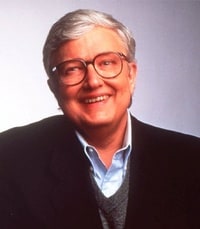
Roger Ebert (1942-2013)
First of all, I've all respect for Roger Ebert. He was the best movie critic ever.
I didn't create this list to diss him or the movies concern but I think it gives an interesting alernative view on some of the greatest movies ever made.
His rating system goes from 0 star to a max 4 stars.
Any suggestion are welcome!
By the way, you are allowed to argue in the comments but if you are going to trash him, your comments will be deleted.
The review comes from his website : rogerebert.com
Added to
People who voted for this also voted for
Films Roger Ebert liked that everyone else dislike
When IMDb and Rotten Tomatoes disagree
Cinema Diary - Vol 4 E3 - Spring 2013
Good reviews for bad movies (by critics)
Authors Hate the Movie Versions of Their Book
10 Reasons the Coen Brothers are Like the Beatles
Things - I find amusing
Too Young For Heart Attacks: Don't show your kids
10 Suggested New Year’s Resolutions for Filmmakers
First Time Viewings of 2012
Films and the critics who hate them
Random Thoughts on Random Films - by Xanadon't
Longest Running Tv Shows!
Seen in 2013
Pixar films in the order I like them
Roger Ebert's favorite movies (2012)
Top 10 best movies 1999
Fun Times with Siskel and Ebert and Roeper
A Complete Review of Terry Gilliam's work
The evolution of Jason Biggs
IMDB Top 10 best movies of the 20’s
A Complete Review of Robert Rodriguez's work
 Login
Login
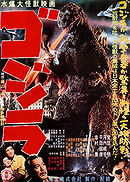
 588
588
 7.4
7.4
 7.5
7.5
